Global Voice of Gas
 BY THE INTERNATIONAL GAS UNION ISSUE 4 | VOL 02
BY THE INTERNATIONAL GAS UNION ISSUE 4 | VOL 02
STOCK OF 2022: WHERE DOES THE MOST TURBULENT YEAR IN GLOBAL GAS MARKETS LEAD?
TAKING


Contents From the President 4 Editor’s Note ............ 6 Events 8 Regional Update Middle East & Africa 10 South & Southeast Asia 12 North Asia & Australasia .......................14 Latin America & Caribbean 16 Europe 20 North America ................................... 22 The opinions and views expressed by the authors in this magazine are not necessarily those of IGU, its members or the publisher. While every care has been taken in the preparation of this magazine, they are not responsible for the authors’ opinions or for any inaccuracies in the articles. FEATURES GLOBAL VOICE OF GAS DECEMBER 2022 3
Dear readers, gas industry colleagues, energy partners, and consumers of gas, 2022 has been the most turbulent and testing year for the energy industry, in particular gas industry and markets, ever. It has also been hard on many other sectors of the economy and populations in general.
The global energy crisis continues, and energy markets are rocked by conflict, high and volatile prices, low supply, and demand destruction. Energy consumers are directly exposed to the energy crisis, with people struggling to pay their bills due to high energy cost. Many had to turn down their heat this winter, several regions have had to endure power shortages, and others are walking through darker streets, or working remotely to conserve energy. Many factories were forced to stop producing, or close down faced with unaffordable energy and deficiency in raw materials.
To navigate through the crisis, many countries had to prioritize energy security over energy transition, as a result we see a growing number of countries adding coal-power capacity, and increased use of coal – the most emitting fossil fuel – all across the world, rich and developing alike. If this trajectory continues, it would be unlikely for us to achieve the Paris goals.
On the upside, we are seeing a positive turn toward new supply investments for gas and renewables, and these trends must continue in order for the global energy balance to be restored. As we wrap up this year and reflect on its many stresses, I hope that a key lesson that can be learned from it is that energy systems cannot be changed overnight, and gas which supplies a quarter of the world’s Li Yalan, IGU President
For more information
Exhibition & Sponsorship Inquiries: exhibition@lng2023.org

Call for Abstracts Inquiries: papers@lng2023.org

About Vancouver: www.destinationvancouver.com
About the Host: www.cga.ca
The 20th International Conference and Exhibition on Liquefied Natural Gas (LNG2023), presented by the International Gas Union (IGU), Gas Technology Institute (GTI) and the International Institute of Refrigeration (IIR), is coming to Vancouver, BC, Canada, between the dates of July 10-13 2023. LNG2023 is hosted by the Canadian Gas Association (CGA).

The largest global LNG conference and exhibition will provide a very unique platform for the global LNG industry and key stakeholders to discuss, debate and showcase the latest industry developments and opportunities.
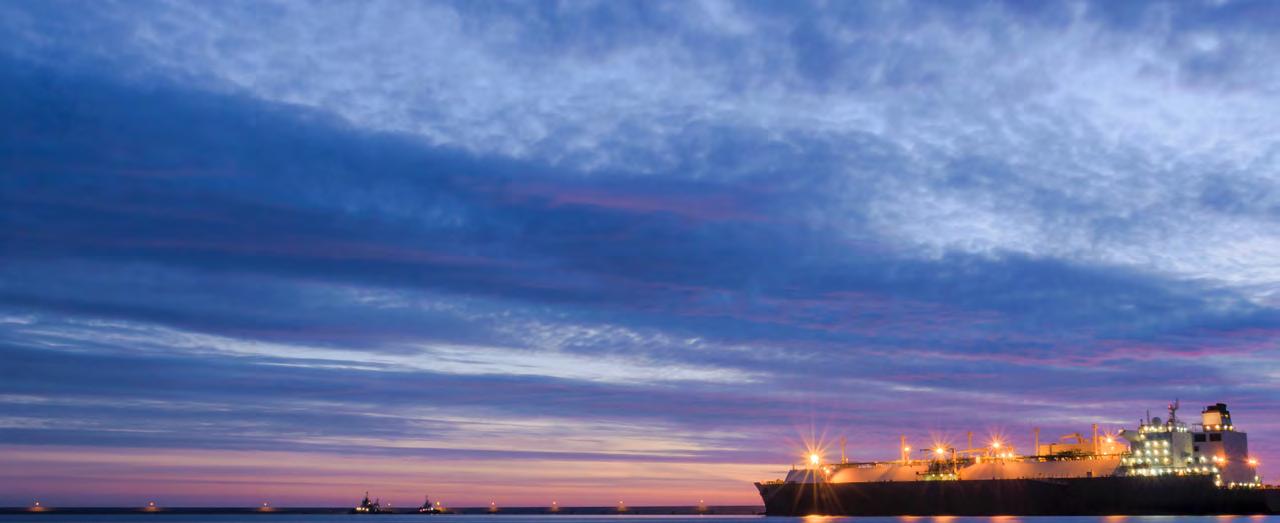
Vancouver is a vibrant, cosmopolitan city surrounded by incredible nature and is an easily accessible destination with direct flights from many corners of the world. The event will be set at the award winning Vancouver Convention Centre, directly on the city’s harbour, within walking distance of numerous hotels, restaurants and local attractions.
The conference programme will present the industry’s leading issues, and the exhibition will host the ultimate industry marketplace.
10-13 JULY
GLOBAL VOICE OF GAS DECEMBER 2022 4
10-13 JULY
Editors’ Note
Welcome to the 10th issue of Global Voice of Gas magazine, an International Gas Union publication, produced in collaboration with Natural Gas World (NGW), a new standard for the global gas community communication worldwide.
We will soon reach the end of what has been the most disruptive year in the history of the gas industry, as well as the energy sector at large. The soaring cost of energy has been exacerbated by Russia’s actions in the European market, but it has been years in the making. While the focus on the mission-critical goal of reaching net-zero was right and must continue, not enough attention has been paid to energy security and affordability. Supply investments fell behind demand growth, and the already out-of-balance energy markets could not withstand the shock of diminishing the volumes of the world’s key gas exporter. This has meant higher costs for people and businesses, closures of production, and energy shortages exacerbating a global cost-ofliving crisis as well as a global food crisis.
This was one of the messages to come out of the COP27 last month, which took place for the first time on African soil since 2016. The conference ended with countries reaching a breakthrough agreement on forming a loss and damage fund, to provide developing countries hit hard by the climate crisis with the support they need. The final text from the conference also contained a provision to expand low-emissions energy, ranging from nuclear and renewable power, but potentially also gas. The value of Africa’s natural gas reserves, as a means to yield greater economic prosperity and lower emissions on that continent and internationally, must be recognised.
In this issue of GVG, Rystad Energy provides an insightful commentary on the prospects for extra gas supply over the coming years, and how much of those volumes can be expected to help ease the situation in Europe, which has seen its Russian pipeline supply drastically reduced.
Mike Fulwood, senior research fellow at the Oxford Institute for Energy Studies, also warns in an interview of the implications that a proposal by EU authorities to impose a price ceiling could have on gas supplies in Europe, stressing that at best, it will be ineffectual, and at worst, could exacerbate the situation by deterring supply, undermining liquidity and posing a risk to financial markets.
This issue also zeroes in on the energy issues affecting Asia – specifically how India and Pakistan are coping with the soaring cost of gas supplies. Unfortunately, this has led to the resurgence of coal and other, dirtier fuels, as it has done in other parts of the world, contradicting climate goals. The issue also provides a global overview of the destruction of gas demand due to high prices, and the implications for coal.
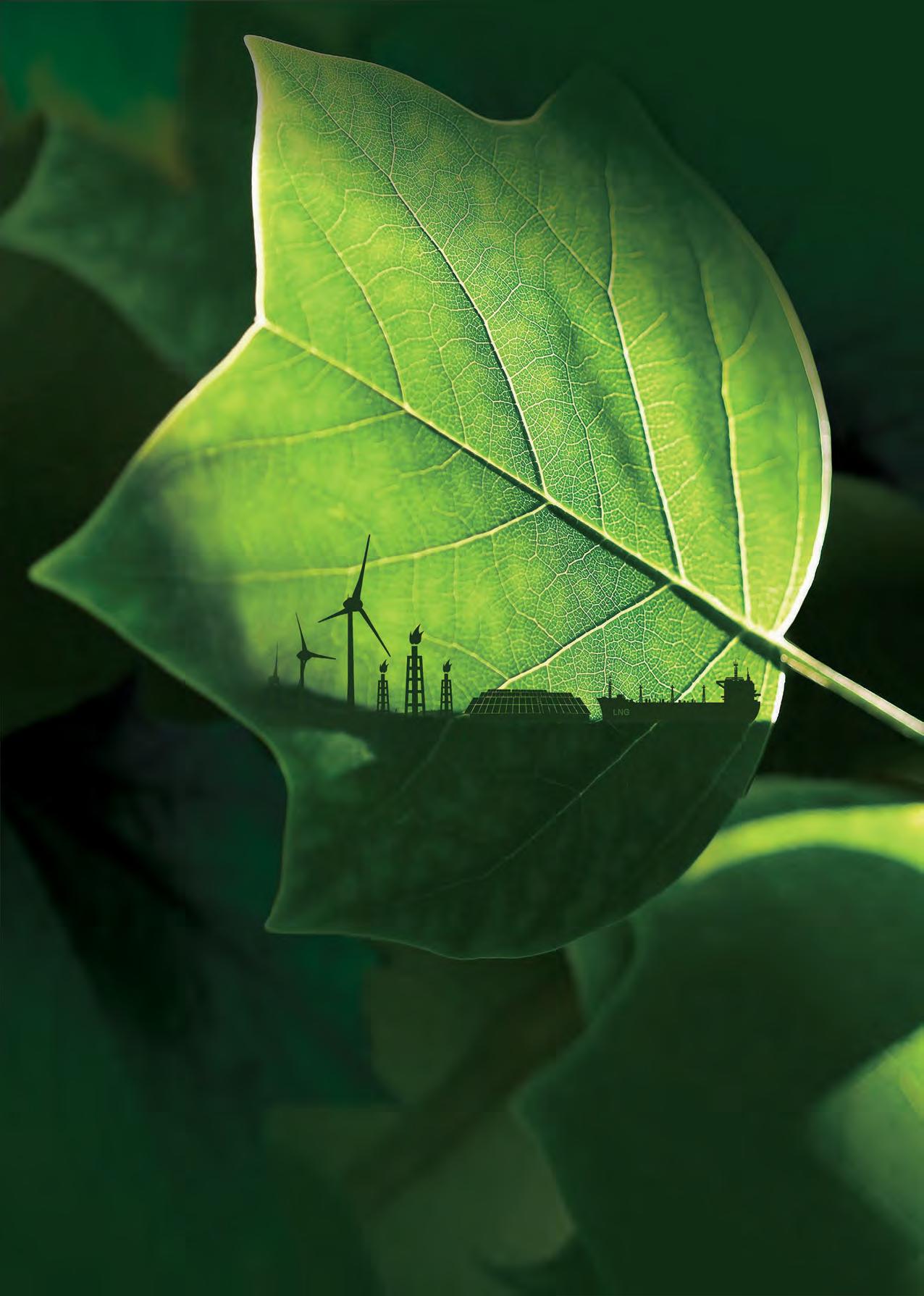
We hope that you will find the insight in this issue insightful and useful in getting a better view of the dynamics affecting the global gas and broader energy markets.

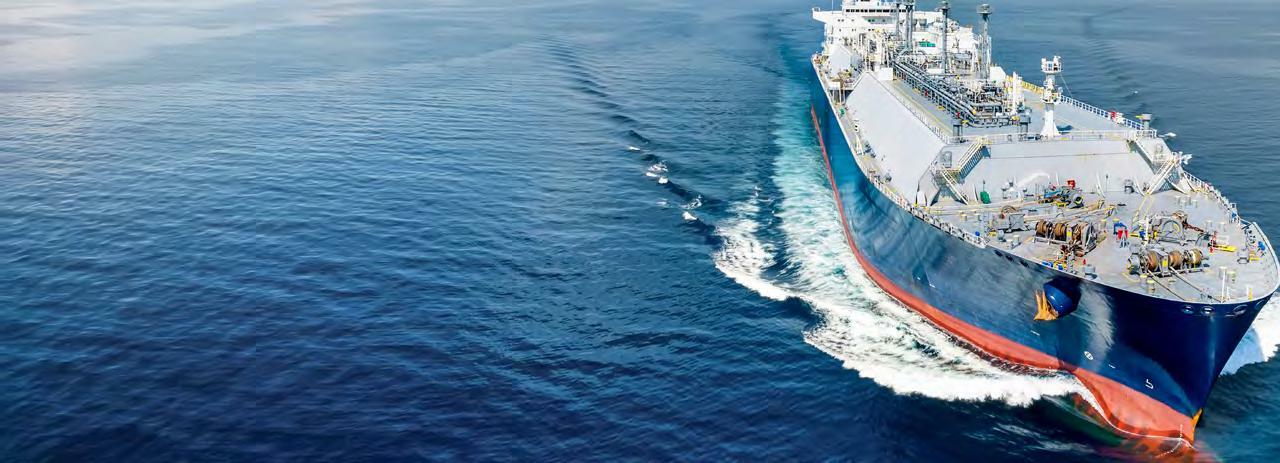 Tatiana Khanberg, Strategic Communications and Membership Director,
Tatiana Khanberg, Strategic Communications and Membership Director,
IGU
Joseph Murphy, Editor, Natural Gas World
GLOBAL VOICE OF GAS DECEMBER 2022 6
The Numbers Stack up for LNG2023
Next thing you know it will be 2023 and we will be in the final countdown to LNG2023 in Vancouver on July 10-13. Here are some headline numbers on LNG2023:

1st: The world’s largest dedicated conference and exhibition for LNG, which also means your most effective networking opportunity in 2023. This is even more important at this time of energy crisis and energy transition.
20th: LNG2023 will be the twentieth in the LNG Event Series dating back to 1968 in Chicago. We are proud to be the “keeper of the flame” for more than half a century.
1,000+: “If you don’t know where you’ve come from, you don’t know where you’re going”. We know exactly where we have come from with around 1,000 fully searchable conference papers (all the way back to 1968) available as a permanent and growing legacy for our industry. Check it out for free at ClubLNGLNG2023
Another 1st: Our first time in Vancouver – a fabulous, easily accessible and safe host city. With the conference centre, restaurants, downtown, waterfront and Stanley Park all within walking distance of many hotels, you can look forward to a great (and effective) time at LNG2023. For hotel details click “VISIT” at LNG2023. Plus, Vancouver is an LNG town with headquarters for the growing LNG industry in Canada. For now the most important thing you can do is make sure you are kept up to date, which you can easily do at ClubLNG-LNG2023. Contact me if you need any further information to help plan your participation at LNG2023.
RODNEY COX Director of Events, International Gas Union

10-13 JULY
LNG2023, the 20th edition of the world’s largest LNG Conference, comes to Vancouver, Canada in July next year. The conference overview is now available to view and industry professionals will find a programme with themes spanning the process of LNG, the business of LNG, and the future of LNG. So check out what you can look forward to!

Hear from global leaders on the most timely and relevant issues then network with the thousands of LNG professionals attending.
Over 250 speakers will lead the debate on issues such as:
·The effect of geopolitical risk and market volatility on LNG commercial activity
·The challenges of a turbulent energy transition
·Fueling the LNG innovation agenda
·Increasing efficiencies and reducing environmental impact
·LNG’s role in Europe’s long-term energy security
·Enabling the transition to hydrogen/ammonia


Plus, the call for papers for the technical programme has yielded an impressive selection of abstracts, peer reviewed by our world leading programme committee chaired by Philip Hagyard of Technip Energies. These papers, which will be first seen at LNG2023, will then form the next chapter in the history of LNG at ClubLNGLNG2023. Here you can find a fully searchable archive of papers presented at all previous conferences, tracing 54 years of the LNG industry’s development. Join ClubLNGLNG2023 for free access as well as receiving all updates about LNG2023.
10-13 JULY
Registrations
for LNG2023 are now open.
Delegate registrations are now open. Book now to save US$1,180 for an early-bird delegate pass (US$3,600). A conference registration gives you the complete LNG2023 experience with access to all conference programme sessions, lunches, refreshment breaks, all LNG2023 networking functions and the world’s largest dedicated LNG exhibition.
LNG2023 is situated at the Vancouver Convention
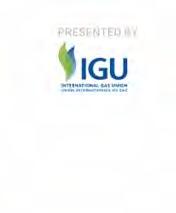
Centre close to the city’s leading hotels; most within walking distance. When you register to attend LNG2023, you will gain access to an exclusive portal for hotel reservations and visa invitation requests. We encourage those requiring visas to enter Canada to apply early as processing times remain relatively long.
Keep up to date at www.lng2023.org and start to plan now to join thousands of your LNG industry colleagues.
IRGC2024
In October, the IGU’s Steering Committee approved the theme for the IGRC2024 conference: Fuelling the Innovation Agenda. This directly answers the global urgency around this topic. Innovation is crucial to achieving our goal of keeping gas as a clean, reliable, and affordable source of energy. The theme allows the conference to expand its traditional focus on technical research to include research academia and organisations, gas clean-tech and new technology start-ups, and an attempt to attract C-suite executives. The IGRC2024 conference will include a holistic view of innovation and technology by including social innovation.
Our next quarterly IGRC2024 webinar should take place the third week of January 2023. The panel discussion will focus on innovation related to the global natural gas vehicle (NGV) industry. Webinar registration will open soon and details will be shared at Gas Pathways.
WGC2025
Save the date for WGC2025 Beijing: May 19-23, 2025

Following the success of the world’s premier conference and exhibition dedicated to natural gas, WGC2022, the International Gas Union (IGU) now looks forward to presenting the 29th edition, WGC2025 Beijing, with host China Gas Society and its partner Beijing Gas Group. The World Gas Conference promotes the role of natural gas in a sustainable future, and provides an ideal opportunity for business leaders, technical experts and policy makers from across the gas sector to meet over a week of conference sessions and networking events. This global event will take place at the China National Convention Centre (CNCC), located in the Olympic Park precinct at the heart of Beijing.

WGC2025 will continue the IGU’s 90 year history of engaging the industry to shape the global energy agenda, share commercial innovations and unpack the latest trends in the sector.
Inquiries: wgc2025@chinagas.org.cn
Preparations are in High Gear for the Must Attend LNG Event of 2023
GLOBAL VOICE OF GAS GLOBAL VOICE OF GAS DECEMBER 2022 DECEMBER 2022 8 9
The Middle East & Africa
KHALED ABUBAKR Chairman, Egyptian Gas Association. Executive Chairman, TAQA Arabia and IGU Regional Coordinator


COP27 and “the year of Africa”

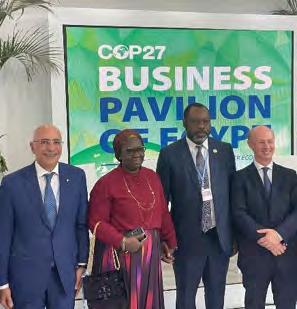

» Egypt succeeded in hosting & organising the COP27 climate conference in its coastal city of Sharm ElSheikh. It was an impressive success from the point of view of organisation, management, safety and security, which were at an impeccable level; in responsibly representing the African continent; in actively participating in all sessions, activities and events of the conference, with remarkable intellectual and scientific contributions; and with respect to the highly distinguished representation by banks, companies, industry and trade associations, universities, research institutes, NGOs and young entrepreneurs. COP27 brought together more than 45,000 participants to share ideas, solutions, and build partnerships and coalitions. Indigenous peoples, local communities, cities and civil society, including youth and children, showcased how they are addressing climate change and shared how it impacts their lives.
» COP27 closed with a breakthrough agreement to provide “loss and damage” funding for vulnerable countries hit hard by climate disasters. Developing countries have been seeking financial assistance for loss and damage – money needed to rescue and rebuild the physical and social infrastructure of countries devastated by extreme weather – for nearly three decades. Finally achieving agreement on a fund is a major milestone.
» The final text of COP27 contained a provision to boost “low-emissions energy”. That could mean many things, from wind and solar farms to nuclear reactors, and coal-fired power stations fitted with carbon capture and storage. It could also be interpreted to mean gas, which has lower emissions than coal, but is still a major fossil fuel. Many countries at COP27, particularly those from Africa with large reserves to exploit,
came to Sharm el-Sheikh hoping to strike lucrative gas deals.
» The Russia-Ukraine conflict is directly exacerbating the food price crisis, bringing to the fore the need for food supply chain resilience. The soaring food prices combined with the impacts of climate-induced droughts could create an even grimmer outlook for food security in coming years. In addition to the food crisis, the scramble by many countries to find alternative sources to energy they used to get from Russia appears to be a setback for the climate agenda as new investments are being made in fossil fuels and new supply routes are being created.
» Launched in July 2022 by the Egyptian minister for international cooperation, the Nexus of Water, Food and Energy (NWFE) Programme aims to accelerate the national climate agenda. The platform provides opportunities for mobilising climate finance and private investments to support Egypt’s green transition, reflecting the interlinkages and complementarity between climate action and development efforts. The programme, part of the country’s national climate change strategy 2050, has secured international support from an international consortium for its energy pillar. The NWFE energy pillar is expected to unlock at least $10bn private investment to install 10 GW of solar and wind energy by 2028, retire 5 GW of inefficient fossil-fuel capacity by 2025, and reduce an estimated CO2 emissions by 17 MTPA.
» The International Renewable Energy Agency (IRENA), cofounding partner Siemens Energy and 13 companies across all industry sectors have launched the global Alliance for Industry Decarbonization. The new alliance aims to accelerate net-zero ambitions and the decarbonisation of industrial value chains in pursuit of the Paris Agreement climate goals. The alliance was created to achieve country-specific net zero goals faster, encourage action for decarbonising industrial value chains, and enhance understanding of renewables-based solutions and their adoption by industry. It will also strengthen dialogue and coordinate action by industrial stakeholders from across the public and private sectors.
COP27
In my capacity as the regional coordinator for Africa at the IGU as well as being the executive chairman of TAQA Arabia, a leading energy and utility provider in Egypt with a great footprint of renewable energy projects in Egypt, I got the chance to attend, speak, moderate sessions and side events during COP27. I also got the chance to join a march encouraging energy justice in Africa. During one of the sessions titled “Towards a Fair Energy Transition” attended by my colleague, IGU Vice president Andrea Stegher, we got the chance to listen to the voice of H.E Hon. Matthew Opoku Prempeh, Minister of Energy of Ghana, who expressed his vision for a fair energy transition for the African continent.
-KHALED ABUBAK, IGU Regional Coordinator
REGIONAL UPDATE
GLOBAL VOICE OF GAS DECEMBER 2022 11 GLOBAL VOICE OF GAS DECEMBER 2022 10
Southeast Asia on the path to net-zero emissions.

Regional Development on Carbon Capture and Storage (CCS)
» In its joint statement to COP27, ASEAN members underscored the importance of implementing the decisions adopted at COP26 to boost financial support for climate action in developing countries. ASEAN urged developed countries to shift and scale up investments in sustainable and climate-resilient infrastructure including CCUS.
South & Southeast Asia
ABDUL AZIZ OTHMAN President, Malaysian Gas Association and IGU Regional Coordinator

supply and infrastructure in the ASEAN region to support its energy transition.
Natural gas remains key for balancing the energy trilemma
» Countries around the South & Southeast Asia region are continuously making progress to address the energy trilemma to ensure greater energy security with reliable, affordable and sustainable supply, while at the same time accelerating the pathway towards a low carbon future. Several countries have also pledged to achieve their sustainability goals by pushing for investment in renewable energy sources, boosting the use of natural gas to provide electricity and cutting the use of coal.
ASEAN joint statement to COP27
» On November 11, 2022, ASEAN member countries issued a joint statement on climate change to the 27th Session of Conference of the Parties to the United Nations Framework Convention on Climate Change (UNFCCC COP-27), where they undermined a commitment to achieve their respective nationally determined contributions (NDCs).
» The ASEAN Plan of Action for Energy Cooperation (APAEC): Phase II (2021-2025) outlined updated regional targets, towards lower GHG emissions through the energy transition. APAEC Phase II emphasised the importance of the continuing role of natural gas in a well-balanced and just energy transition, including the need to enhance the connectivity and accessibility of gas and LNG supplies and for the region to tap more of its indigenous energy resources.
» The joint statement also welcomes cross-ASEAN cooperation and coordination, amongst others, the development of the ASEAN Taxonomy for Sustainable Finance (ASEAN Taxonomy) which would help further develop gas
» Southeast Asia is a vibrant and growing region, with surging energy demand. Electricity demand alone has tripled over the last two decades of growth and is expected to triple again by 2050, as the region’s rapidly developing economies seek to meet surging residential and industrial demand. According to Boston Consulting Group’s (BCG) timely analysis, natural gas as an important source of energy offers a path to help bridge the gap and will still be an important pillar of energy supply in the region, complementing the renewable growth, balancing the energy trilemma whilst maintaining economic growth for the region.
» As the energy transition progresses as an enabler of energy security, efforts are further strengthened through emerging technologies advancement across the ASEAN region together with comprehensive energy policies and roadmaps established to achieve the region’s ambitions. According to the International Energy Agency (IEA), cleaner technologies solutions such as carbon capture, utilisation and storage (CCUS) can help to put the fast-growing economies of
» At least seven potential CCS projects have been identified In Southeast Asia and are in early development stages – in Indonesia, Malaysia, Singapore and TimorLeste. The CCS Gundih Project in East Java, Indonesia, is regarded as the first CCS pilot project in the ASEAN region, while the Kasawari CCS project in Malaysia is expected to be the largest offshore CCS project in the world, capturing between 3.7 to 4 MTPA of CO2 from 2025. With the second Lang Lebah CCS project following closely behind, Malaysia aspires to be a leading and attractive regional CCS solutions hub.
» The national oil companies in Southeast Asia are taking the lead in driving CCS projects by collaborating with international experts. Most recent collaborations include:
- Malaysia’s PETRONAS and Royal Vopak N.V, the world’s leading independent tank storage company from the Netherlands signed an MoU to explore opportunities in developing a value chain for CCS in Southeast Asia.
-During the G20 Summit in November 2022, US President Joe Biden announced the $2.5bn agreement between ExxonMobil and Indonesia’s Pertamina on carbon capture.
-Thailand’s PTTEP initiated collaboration with Japan’s Inpex and JGC Holdings Corp (JGC) to explore the potential development of a CCS project in Thailand.
Regional Development on Carbon Capture and Storage (CCS)
» Petronas, the first energy company in Asia to commit
to net-zero by 2050, released its Net Zero Carbon Emissions by 2050 (NZCE 2050) pathway to accelerate and advance group-wide actions and commitment towards achieving this goal. Petronas’ decarbonisation effort will involve zero routine flaring and venting, energy efficiency, electrification and CCS.
» During COP27, Petronas announced it would become a signatory membership to the United Nations Environment Programme’s (UNEP) Oil and Gas Methane Partnership 2.0 (OGMP 2.O), as well as the International Renewable Energy Agency’s (IRENA’s) global Alliance for Industry Decarbonisation as part of its commitment to strengthening its methane emissions management, as well as decarbonisation efforts and the scaling up of cleaner energy solutions to achieve NZCE 2050.
Countries around the South & Southeast Asia region are continuously making progress to address the energy trilemma to ensure greater energy security with reliable, affordable and sustainable supply, while at the same time accelerating the pathway towards a low carbon future. Several countries have also pledged to achieve their sustainability goals by pushing for investment in renewable energy sources, boosting the use of natural gas to provide electricity and cutting the use of coal.
REGIONAL UPDATE
REGIONAL UPDATE
GLOBAL VOICE OF GAS GLOBAL VOICE OF GAS DECEMBER 2022 DECEMBER 2022 12 13
North Asia & Australasia
SATOSHI YOSHIDA Senior Adviser, Japan Gas Association, and IGU Regional Coordinator.

» Entering November, the LNG spot price in Asia has fallen below $30 per mmBtu, down 60% from a record high of almost $70 in late August, when there was concern that Europe would have insufficient natural gas this winter due to curtailed supply from Russia.
» This drop may have resulted from expectations of a milder winter, and high levels of gas in storage in Europe.
» Asia imported more LNG in November than in October, thanks to increased Chinese purchases.
» Overall, though, Chinese LNG imports dropped in 2022 because of the high cost of spot LNG, with supplies confined to long-term contractual volumes, fixed at lower prices.
China
» Chinese LNG importers have been selling their excess inventories to Europe to make up for lost Russian supply. But this should end, as the National Development and Reform Commission (NDRC) has told China’s state-owned LNG importers – Sinopec, PetroChina, and China National Offshore Oil Corporation (CNOOC) – to stop this practice as winter approaches.
» CNOOC announced that China’s first LNG carrier and refuelling vessel “Offshore Oil 301” was put into service in November. The vessel, originally an LNG carrier with a capacity of 30,000 cubic metres, has been retrofitted to make it capable of refuelling. Ship-to-ship refuelling, versus traditional onshore refuelling, shortens the time of a ship’s port call and enhances the international competitiveness of ports.
» CNOOC is building international LNG refuelling centres in the Pearl River Delta and Yangtze River Delta regions. LNG refuelling vessels are expected to promote the use of LNG as a shipping fuel.
» Sinopec and Qatar Energy signed a long-term agreement for 4 MTPA of LNG supply over 27 years – China’s longest such deal. Deliveries will start in 2026.
Japan
» Japan, the world’s second largest LNG buyer, is focusing on securing LNG supplies next year as the market remains tight. The country is relatively well-placed as many of its LNG contracts are long-term and are oil index-priced and not fully exposed to spot prices. Nevertheless, the average LNG import cost for Japan is expected to double in 2022.
» As of October, Japan had 2.5 MT of natural gas in reserve, equal to two weeks of demand, which is 40% higher than the five-year average. Japan imported 70.4 MT of LNG in 2021.
» Earlier this year, Prime Minister Fumio Kishida announced that Japan will restart seven nuclear reactors by mid-2023 to help reduce dependency on imported LNG. The latest government’s energy plan shows that nuclear power will account for 20% of the power mix by 2030, bringing the share back to where it was before the Fukushima disaster.
» The ministry of economy, trade and industry (METI) is proposing to extend the lifespan of nuclear reactors beyond the current 60 years to ensure stable power supplies and also reduce GHG emissions. A final decision is expected to be made by the end of this year.
» After Fukushima, Japan also resorted to more coal use. Its largest power producer, JERA, plans to start up a new 1.07GW coal-fired power plant in central Japan this year.
» As it scrambles to secure enough LNG for winter, the government announced a $875mn loan in October to help utilities to pay for cargoes. The Japan Bank for International Cooperation (JBIC) also announced it would lend nearly $700mn to JERA for the same purpose. According to the government, JOGMEC will be able to buy LNG directly this winter if private firms cannot afford cargoes.
» The government has called on residential and industrial consumers to save electricity this winter. The law will be amended to allow the government to request large gas consumers to restrict their gas use if shortages are expected.
» Japan and Thailand have signed a memorandum of understanding (MoU) to share LNG in times of serious shortages to boost energy security. The MoU is also targeted at enhancing cooperation between Japan and Thailand in the field.
New Zealand
» City gas currently accounts for approximately 9% of New Zealand’s total GHG emissions (residential 1%, commercial and industrial gas 8%).
» In March of 2021, Firstgas, New Zealand’s largest gas network company, announced a plan to decarbonise New Zealand’s gas pipeline network with hydrogen. Hydrogen will be blended with city gas starting in 2023 and will replace natural gas fully by 2050, under the government’s plan, requiring new appliances. Trials in a distribution network will start in 2023. This strategy means natural gas infrastructure will continue to play an important role in a zero-carbon future.
Australia
» Australia joined the Global Methane Pledge this year, a voluntary commitment with 122 signatories including the US, the UK and the EU, collectively aimed at reducing global methane emissions across all sectors by at least 30% below 2020 levels by 2030. Japan, South Korea and New Zealand are also signatories.
» Australia’s government has said the supply of gas and coal will not be disrupted by federal measures to curb rising domestic energy prices. In August, Australia announced that it is considering restricting exports of LNG next year to avoid a potential shortfall in domestic supply, but this was avoided with a deal with exporters to ramp up domestic supplies.
South Korea
» South Korea’s government raised natural gas reserve
inventory requirements. KOGAS, the country’s only LNHG imports will now have to keep nine days of national gas demand in storage, up from seven days previously. This is part of a broader gas supply and demand plan announced in April.
» South Korea revised its legislation governing the development of its urban gas business to include LNG for vessel use in August, as part of an effort to promote its domestic LNG bunkering. LNG bunkering fuel suppliers will no longer require government approval on the price and volume of LNG imports, although the government must still be notified of any import plans. According to the Korea Energy Economics Institute (KEEI), South Korea’s LNG bunkering market is expected to expand from 1.3 MT in size in 2030 to 3.4 MT in 2040.
KOGAS plans to develop an LNG bunkering facility in Dangjin on South Korea’s northwest coast, with a new LNG receiving facility expected to be completed in 2025
Chinese Taipei
» Chinese Taipei imports 99% of its natural gas, and authorities continue to fortify natural gas infrastructure. Besides the two existing LNG terminals which are owned by CPC, there are three more (one by CPC, and two by Tai Power) under construction or at the planning phase.
» The government’s goal is to expand gas-fired power generation capacity to 50% of the energy mix by 2025. It also wants to expand mandatory LNG reserves to 20 days by 2025 and 24 days or more by 2027.
» CPC’s Taichung LNG terminal is now undergoing its third expansion phase. This will involve installing two new LNG tanks and regasification facilities, due to be commissioned in 2026. SOFREGAZ was contracted by CPC for front-end engineering and design (FEED) and project management consultancy (PMC) for the project. PECL was hired for a feasibility study and environmental impact assessment. Daigas Gas and Power Solution (DGPS), a 100% subsidiary of Osaka Gas in Japan, was awarded a FEED and technical consulting service contract for a fourth expansion phase in April this year.
REGIONAL UPDATE
REGIONAL UPDATE
GLOBAL VOICE OF GAS GLOBAL VOICE OF GAS DECEMBER 2022 DECEMBER 2022 14 15
Latin America
CARLOS CORTES SIMON Executive Chairman At Asociacion De Empresas De Gas Natural and IGU Regional Coordinator

company TotalEnergies, had not confirmed the arrival of four LNG tankers to the country next year, which so far is a direct effect of the conflict in Ukraine. The system operator projected the need for 22 vessels in 2023, and therefore unconfirmed vessels represent about 18% of the total estimated requirement, which could compromise the safety and minimum cost of supply to the National Electric System (SEN). On the other hand, supply for the Quintero terminal (SPA agreements between GNL Chile and Shell) has been secured through the confirmed 2023 ADP with 38 shipments scheduled to unload next year.
of 2021. As rainfall recovered in south Brazil and the northeast of Argentina, hydroelectric output increased by 1.5% year on year in September, reaching 54% in October and 72% of capacity in November. Industrial demand is moderately up by 3.1% over the past three months, averaging a healthy 36 mcmpd average.
from offshore associated gas, with reinjection volumes reaching new record levels in August 2022 (69.6 mcmpd), and an available supply to the market of 48.8 mcmpd.
» To make up for insufficient domestic supply, Brazil imports gas from Bolivia by pipeline and LNG from international suppliers. The revised contract with Bolivia calls for 20 mcmpd of take-or-pay gas, whereas LNG imports vary due to the intermittent dispatch of gas-fired power plants.
The
region remains one of the areas in the world with the highest energy poverty
» After Africa, this region remains one of the areas in the world with the highest energy poverty. The use of natural gas for cooking and heating could reduce inequality and provide solutions for public health. Colombia has the largest coverage in the region with 67%, followed by Argentina with 61% and Peru with 14%.
» In Argentina, LNG imports for winter 2023 may be lower than in winter 2022, as the second regasification vessel at Bahia Blanca port has not yet been contracted, and the forward prices appear to be 30% higher than the record-high $30 per mmBtu paid during 2022. Gas imports from Bolivia in 2023 will require negotiations before the end of this year but may be lower than the average 13.5-14.0 mcmpd during the winter months in 2022. Gas production is expected to increase by winter 2023, depending on the effective completion of Stage I of the new gas pipeline from Neuquen basin to Buenos Aires. High activity at the Neuquen basin as well as Northern and Southern Santa Cruz will be maintained both regarding oil and natural gas, to add additional volumes in the winter months and offset the very high-priced volumes of LNG.
» In Brazil, the newly elected government will intensify actions to achieve its environmental goals, planning further development of renewable energy and reinforcing the role of natural gas in the country’s energy transition in 2023. There are expansion plans for gas transport companies in Brazil with an estimated investment of 10bn realis ($2bn) over the next five years.
» In Chile, in mid-November Engie informed the National Electricity Coordinator that its gas supplier, fellow French
» In Colombia, the outlook for 2023 is promising to the extent that the foundations of the 2023-2026 National Development Plan will be put in place, which will outline the path that the nation will follow during the administration of President Gustavo Petro and in which natural gas will play a fundamental role as enabler of the transition, the reduction of inequality, sustainable mobility, food security and the fight against climate change.
» In Trinidad and Tobago, despite new gas production coming on stream, their total gas supply is still below LNG and domestic demand, thus paving the way for securing crossborder gas from Venezuela, subject to US Sanctions.
Argentina
» After peaking at 141.5 mcmpd in August 2022, gas production has fallen because of seasonal demand. Domestic production at the Northwest basin of Argentina continued its longstanding decline at 6.6% year on year in October, and output in the southern Austral basin (onshore and offshore) declined at a more moderate rate of 4.3%. The oil-prone Golfo de San Jorge basin saw a 7.8% increase in production year on year, with the development of new gas reservoirs. Despite transportation capacity restrictions and limited regional demand, incremental exports to central Chile at an average of 7.8 mcmpd during November were 38% higher than November 2021 and allowed for a 7.3% increase in gas supply from the Neuquen basin.
» Overall domestic demand for natural gas dropped after a peak in the winter months. Not only did residential and commercial demand diminish as a consequence of higher temperatures after the winter, but also demand for power generation was significantly lower than in the similar months
» Fenix, the large offshore gas development at the Austral basin was announced by the consortium of TotalEnergies, Wintershall DEA, and Pan American Energy. This large project is targeted to come on stream by the end of 2024 or early 2025, and will produce 10 mcmpd of gas, offsetting supply decline in the basin in recent years that is expected to continue in 2023 and 2024.
» The dry shale gas wells in the Vaca Muerta formation, with the recently extended 3,000-metre lateral leg wells, averaged more than 550,000 mcmpd of output in their third and fourth months of production. High initial production at the shallower tight gas wells at Neuquen basin resulted in high production rates averaging 350,000 mcmpd during their second and third months of initial production.
» Gas transport capacity constraints along the Parana river between Buenos Aires and Rosario (Argentina’s two largest cities and where heavy industries are located), impeding adequate supply to several combined-cycle power plants. Those plants are forced to consume mainly imported diesel to satisfy the high regional demand. The main 570-km trunk line from the Neuquen basin to Salliquelo at the west of the province of Buenos Aires (Gasoducto N. Kirchner), is already under construction. Pipes are being laid and welded and the pipeline is due to start up on June 20, 2023, with an initial capacity of 11 mcmpd. An international tender is underway for the supply and installation of two compressor stations before the 2024 winter, to expand capacity by a further 11 mcmpd
Brazil
» Domestic gas production in Brazil continued to increase, reaching 135.3 mcmpd in 2022, compared with 132.6 mcmpd in the first half of 2021. In 2022, approximately 86% of Brazil’s production originated
» There are currently five LNG terminals in operation (all FSRUs), one in construction (in the southern state of Santa Catarina) and another three planned for 20242025.
» Petrobras was supposed to complete the offshore pipeline Route 3 in the second half of 2022, allowing the supply of 18 mcmpd of gas, but completion has been postponed to 2023.
» The development of a number of biomethane and biogas projects will work as “distributed generation.” Some of these projects require access to gas transport networks, thus the need to assure the same quality standards.
» The emergence of hydrogen projects will cause a sharp increase in renewable energy capacity. Green hydrogen and ammonia projects have been announced at Porto de Pecem (Northeast) and Porto do Açu (Southeast).
Colombia
» Colombia has one of the greatest examples of mass gasification, with a coverage of 80% reaching 36mn users. Colombia’s main demand comes from industrial customers followed by residential clients.
» This industry, according to figures from the Colombian Natural Gas Association, contributes 1% of the national gross domestic product (GDP), employs around 100,000 people and contributes close to $1bn/yr in royalties for the nation.
» Based on this, it is expected that in 2022-2024, upstream investments will amount to $2.86 trillion, to
REGIONAL UPDATE
REGIONAL UPDATE GLOBAL VOICE OF GAS GLOBAL VOICE OF GAS DECEMBER 2022 DECEMBER 2022 16 17
ensure gas supply and thus take advantage of the availability of this resource to leverage the energy transition.
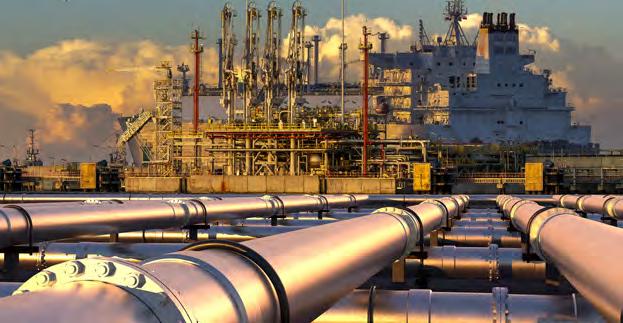
» In June 2022 a new president was elected (Gustavo Petro), from the hard left. It is expected that he will move the country towards eliminating oil, gas, coal and all mining operations in the next 20 years, as Petro seeks to prohibit the exploration of the extractive industry and preserve the contracts currently signed. However, recently Petro has made a statement about the role natural gas will play during his administration in reducing emissions and costs.
Chile
» During the first three quarters of the year, 55% of the imported gas came in LNG form. The remaining 45% came from Argentina. This trend shows a change in the way gas is supplied to Chile, which has principally been LNG for the last 13 years.
» During the winter season, Argentina continued to export gas to Chile. The volumes were lower than in the summer, but they were steady. From October onwards, these exports to Chile are set to increase considerably and will probably be even higher than in last year’s summer season.
» Natural gas has continued to be an important component for electricity generation, representing 19.6% of the power mix. On the other hand, solar and wind power output has seen sustained growth and is now 27.2% of the mix. Solar and wind even surpassed coal in terms of the share of mix, contributing 29% and 27% respectively in the last 12 months.
» Finally, the energy ministry has announced the formation of a group of experts and academics to review the regulatory framework of the entire gas industry. They began their work in November, with the aim of guiding and proposing the main legal modifications to (probably) regulate the access, use and development of regasification infrastructure, and the storage and transport of natural gas. These proposals should be a central part of the bill that the government will send to congress during the first semester 2023.
Trinidad & Tobago
» Negotiations between the Trinidad & Tobago government and the Atlantic LNG shareholders (BP, Shell & NGC) on reaching commercial agreements for the unitisation of the Atlantic trains are still ongoing.

» The impact of the Ukraine/Russia war saw ammonia prices skyrocket to nearly $1,600 per T in late-March to mid-April 2022. Prices have dropped and continued price depreciation is expected in January and throughout the first quarter of 2023. Europe’s gas situation remains precarious, and any significant shift in either gas prices or in the ammonia market fundamentals can significantly impact pricing.
» NGC achieved Gold Standard status of reporting under the Global Oil and Gas Methane Partnership (OGMP) 2.0. This achievement, attained by companies with clearly elaborated targets to reduce methane emissions by 2025, comes just one year after the company joined the OGMP community.
» NGC also signalled its commitment to transparency and alignment with global best practices, with the publication of its fifth annual sustainability report, covering 2021.
» The ministry of planning and development and the United Nations Development Programme launched the largest ever grant-funded project in T&T aimed at reducing ozone depletion as well as the climate change ambitions. The Global Environmental Facility grant valued at US$5.15mn will be used over a four-year period to create a sustained market change towards the adoption of low-carbon refrigeration and air conditioning technologies in the country.
» In November 2022, Hydrogen De France (HDF), launched its local branch, HDF TT, paving the way for the company to begin its first of many local hydrogen projects.
» Construction is expected to start in the first semester of 2023 on two solar plants with a combined capacity of 112 MW.. The electricity distributor T&TEC has commenced public sensitization campaigns aimed at educating the public on the transition to clean energy and diversifying energy sources.
GLOBAL VOICE OF GAS DECEMBER 2022 18
INTRODUCING
Europe
DIDIER HOLLEAUX President of Eurogas and IGU Regional Coordinator

The ongoing conflict in Ukraine means that the outlook for the European natural gas industry remains highly uncertain. Despite some short-term relief, due to warmer than usual weather in early autumn, the situation for the European gas industry remains much the same as described in the previous GVG issue.
» The flow of Russian pipe gas to Europe has fallen from 143 bcm in 2021 to the annual equivalent of about 30 bcm since September.
» Despite this significant reduction, Europe succeeded in filling up its storages for the beginning of the winter.
» This was achieved by maximising LNG imports and making best use of Europe’s gas infrastructure, including the reverseflow at border points. This infrastructure will be reinforced with the addition of three new FSRUs by the end of the year. The Greece-Bulgaria pipeline has already been put into operation.
» Strong demand reduction is also needed in all European countries (figures above a 30% reduction have been reported for industry in some countries, and 10-15% are common for tertiary and domestic customers).
» Within-day and day-ahead gas prices dropped below €20 ($21) per MWh, as a result of high levels of storage and warm weather in October and November, but front-month prices stayed at around or above €100 per MWh, reflecting buyer sentiment that supply will remain tight this winter.
» If supply does remain tight this winter, or even desperately short for some east European countries with limited storage
and supply options, countries in the west expect to be able to cope, unless the weather is unusually cold, and are now focusing their efforts on ensuring sufficient gas next spring and next winter, partly by adding an extra 10 FSRUs.
» Despite the launch of new lNG plants like Calcasieu Pass in the US and Mozambique LNG and Coral Sul in Mozambique, the supply situation in Europe next year is expected to look much like the one in the autumn of 2022.
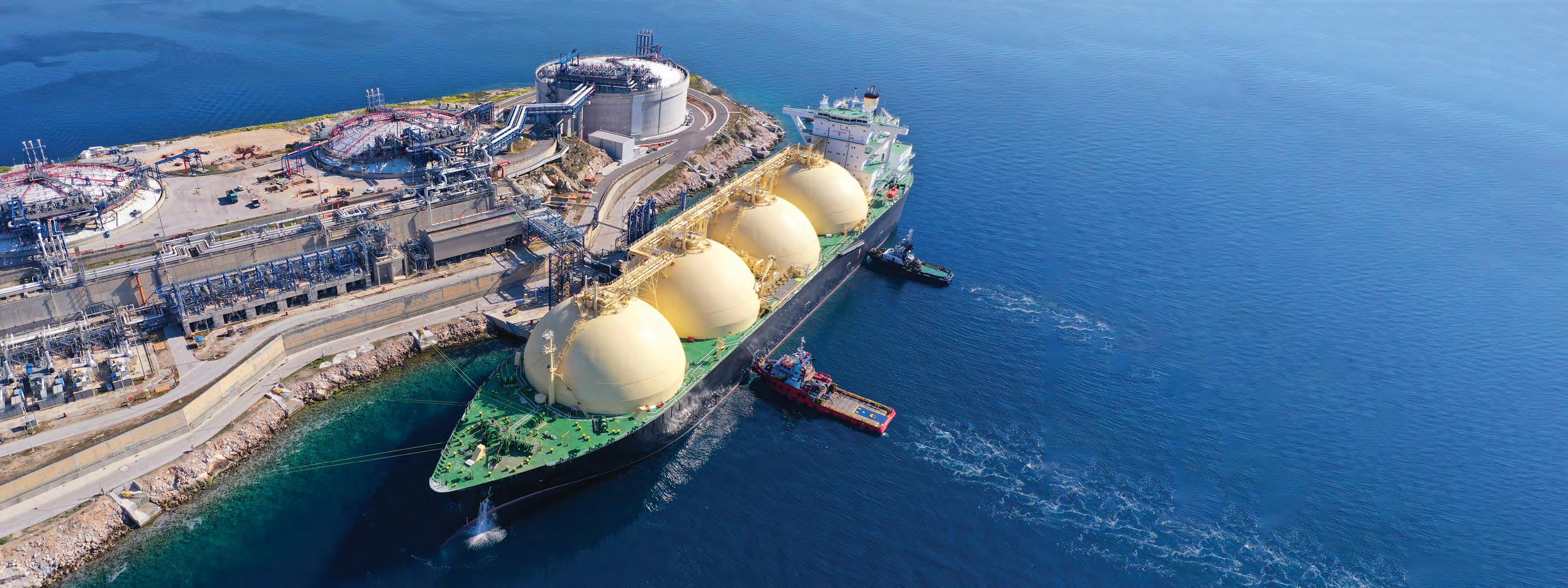

» On the demand side, many countries have introduced subsidies to limit the price paid by different categories of customers. These subsidies are very costly, and are complemented by measures to encourage reduced consumption. Some measures are set to be extended in 2024.
» Discussions are taking place between gas importers and suppliers, but few contracts have been signed to replace the lost Russian gas in the medium term.
» As long as the war in Ukraine continues, so will the European gas crisis, and resulting higher LNG prices will also impact most LNG importing countries. If the number of new long-term gas and LNG contracts that trigger new investments is not enough, existing production and liquefaction capacity globally will not be enough to replace the 110 bcm or more missing Russian supply, and the crisis may drag on beyond 2026.
BUILDING VISIBILITY OF GAS AND GAS FOCUSED TECHNOLOGY AS A PERMANENT AND GROWING PART OF THE GLOBAL ENERGY MIX
Natural gas can continue to play its significant economic and environmental role in the global energy mix for decades to come, offering clean, secure, and affordable energy for global citizens.The extent to which the industry demonstrates and effectively communicates the key role of gas in a sustainable energy future, against the backdrop of a groundswell of anxiety about climate change, environmental, economic security, and political risks will determine theextent of its continuing success.
OFFICIAL MEDIA PARTNER
GASPATHWAYS.COM
Gas Pathways is being developed with a view to becoming the authoritative, credible, and fact-based national and international communications platform amplifying the innovation agenda around gas energy –and gas energy infrastructure; demonstrating that the natural gas sector is focused about making affordable energy available to all, and about maximizing resiliency in energy delivery.


REGIONAL UPDATE
GLOBAL VOICE OF GAS DECEMBER 2022 20
North America
EGAN CEO


Gas production rises and rises

» As the world continues to weather the challenges posed by the various dimensions of the global energy security crisis, the North American industry continues to build one of its key responses: record natural gas production (again). North American energy prices have been affected by the pressures affecting global markets, as indicated by higher-than-average prices, but in comparison to other regional markets across the globe North American gas remains incredibly affordable, and the continent has an abundant supply.
» US midterm elections saw the Democrats hold their thin Senate control but lose the House of Representatives, likely posing some challenges for the Biden administration’s aggressive emissions reduction agenda, as embodied in the Inflation Reduction Act. How natural gas will play in the new congress discussions remains to be seen, but natural gas production levels continue to reach record after record, a trend likely to continue. In addition, the US is on pace to become the world’s largest LNG exporter, and new gas transport and LNG export infrastructure continue to be built at a frenzied pace.
» In Mexico, as the demand for natural gas increases, the AMLO government continues showing strong support for the development of new natural gas infrastructure. The Southeast
Gateway project has made meaningful progress since being announced in July 2022 and highlights the value of privatepublic sector cooperation as a means to achieve economic well-being while addressing social concerns and cleaning up the environment. Domestic natural gas production has seen consistent growth this year in Mexico, resulting in a drop in US imports.

» In Canada meanwhile, gas prices remain amongst the lowest in the world. Despite increasing end-use demand, market conditions, and carbon taxes, natural gas remains the most affordable heating option in most applications – cheaper than electricity, propane, and heating oil. Natural gas production has reached record highs in Western Canada and is expected to continue growing this winter. While there is growing support for natural gas from indigenous communities in Canada and increasing pressure from international partners to expedite export development, senior government officials seem divided on their energy security agenda. The policy framework continues to be a roadblock, preventing Canada from capitalising on the significant global LNG demand. The good news on that front is continued progress on LNG Canada’s Kitimat, BC project which has entered its above-ground construction phase and is on track to be operational in 2025.
» The timeliness of the upcoming LNG2023 conference in Vancouver cannot be underemphasized given global events. As we build towards it, the North American IGU members are working to ensure greater coordination than has existed in the past. As part of that, we have agreed to participate in a North American Natural Gas Forum in late February 2023 in Calgary, with representatives from Mexico, the US, and Canada. Hosted by CGA as part of its ongoing Gas Dialogues series, the event will be an important occasion to discuss the role of Gas in North America and the role of the North American industry in the global conversation.
REGIONAL UPDATE
TIMOTHY
of the Canadian Gas Association and IGU Regional Coordinator
GLOBAL VOICE OF GAS DECEMBER 2022 22
2022: the most turbulent year in history for gas markets
War in Ukraine pushes gas markets into structural deficit
Kaushal Ramesh RYSTAD ENERGY GAS AND LNG MARKETS RESEARCH


2022 will be remembered as the most turbulent year in the history for global gas markets (so far).
The year began on an uncertain note with Russian pipeline supplies to Europe at 247 mcmpd, having averaged around 320 mcmpd in 2021. A milder-thanexpected winter and the impending approval of the contentious Nord Stream 2 pipeline allowed TTF prices to decline to $25 per mmBtu before Russia sent troops into Ukraine in end-February, upending global gas balances and setting the scene for a sustained supply deficit.
Since then, European gas prices have been extremely volatile and twice went on a record-breaking streak, closing in August at an all-time high of over $90 per mmBtu. Assessments for the Asian spot LNG price replicated much of these moves in direction but not in magnitude, ranging between ~$60-$80 per mmBtu in the same timeframe, as China continued their strict zeroCOVID policy and other price sensitive buyers in Asia retreated from large spot purchases.
Naturally, much attention was focused on how the war would impact Russian pipeline gas supply into Europe. In 2021, this source made up ~30% of the gas consumption of the EU 27 and the UK. As the market feared an impending halt in these volumes due to sanctions by the West or a potential weaponization by Russia, volumes
were lifted to ~330 mcmpd by mid-March but have since slowed to a trickle of ~85 mcmpd. The period in between saw Russia halt exports through the Yamal-Europe pipeline, and then through the Nord Stream 1 line after maintenance in July. In late September, explosions from alleged sabotage rendered Nord Stream 1 technically inoperable for the foreseeable future.
Global gas production declined on the year by 0.5% as the war with Ukraine and Europe’s directional shift to LNG led to Gazprom curtailing production. Production from Russia is likely to drop next year as well due to sanctions risk, the exodus of foreign partners and a decline in upstream investment. Overall, the outlook for Russian hydrocarbon production faces a downward revision from pre-war estimates.
The elevated spot market price environment however allowed Europe to import record volumes of LNG – high prices attracted the needed supply rerouting many cargoes with the fuel from other potential destinations.
Between January to November, the continent imported ~66% more LNG year on year, with US LNG driving the bulk of that increase. By April, Norway overtook Russian pipeline gas as Europe’s largest gas import source, while US LNG volumes have exceeded those of Russian pipeline gas from June onwards . By November, more than half
of Europe’s gas imports was through LNG. Europe also continues to import large volumes of Russian-origin LNG, having imported close to 17 MT (~23 bcm) from January through November.
However, high prices, demand control policies, and demand destruction kept European gas consumption subdued, allowing them to hit their storage fill target of 80% by August – two months in advance (as an energy security provision in response to the crisis, the EU implemented a requirement for all its natural gas storage reservoirs to be filled to at least 80% level by November).
By mid-November, storage had hit ~95% capacity, aided by a milder than expected start to winter. The demand destruction was primarily in the industrial sector as high gas prices and indirectly high electricity prices made production in energy-intensive facilities like steel and fertilizer plants uncompetitive.
The Northern Summer (and Southern Winter) of 2022 demonstrated the importance of gas in the power system as a fuel of last resort. Despite widespread fuel switching efforts in the power sector and an increase in coal usage, gas fired power generation was forced to increase ~ 6.8% across the first nine months of the year due to an unseasonably hot summer with concurrent heatwaves, coupled with ~15% lower nuclear power generation and
~20% lower hydro generation. Even in the US, soaring power demand allowed the Henry Hub to shrug off the bearish impact of the Freeport outage. Between May to July, gas’ share of the US power mix (Lower 48) had risen from 35% to 43%. Meanwhile, in the southern hemisphere, gas was called upon to support power demand as nearly 5 GW of coal fired capacity got taken offline in Eastern Australia for planned and unplanned maintenance.
Prior to the war in Ukraine, Asian gas demand was on a rising trend across all consumption sectors.. Policy was a driving factor, with natural gas’ relatively clean credentials touted as the bridge to a low emissions future in place of coal and fuel oil to power Asia’s economic growth. Through the year however, Asia played second fiddle to Europe as an LNG import market, a trend that will likely continue for as long as Europe is in deficit. Rolling COVID-19-related lockdowns in China devastated its industrial gas demand. The country is expected to import less than 65 MT of LNG in 2022, an 18% reduction from 2021. Pakistan and Bangladesh in price sensitive South Asia were forced to endure rolling blackouts and curtailed industrial production during the summer heatwaves. Even OECD Japan and South Korea implemented demand control and
0% 10% 20% 30% 40% 50% 60% 70% 80% 90% 100% 0 1 2 3 4 5 6 7 8 9 Jan 2020 Mar 2020 May 2020 Jul 2020 Sept 2020 Nov 2020 Jan 2021 Mar 2021 May 2021 Jul 2021 Sept 2021 Nov 2021 Jan 2022 Mar 2022 May 2022 Jul 2022 Sept 2022 Nov 2022
Spot Contracted% Spot (RHS)
GLOBAL VOICE OF GAS GLOBAL VOICE OF GAS DECEMBER 2022 DECEMBER 2022 24 25
China’s LNG imports by contracted and uncontracted volumes (MT, % RHS)
fuel switching measures to limit consumption. In South America, improved hydro power output reduced LNG import requirements by close to 40% across January to November.
2022 will also be remembered as the year in which Europe overtook Asia as the center of LNG demand, while the US – with 56% of the LNG project pipeline through 2030 – has become the centre of future LNG supply. Accordingly, commercial activity is concentrated in the US from where more than 70% of 2022 contracted volumes have originated. Portfolio players have been the largest buyers of US LNG with around 28 MTPA or 38 bcma of confirmed offtake. The US will play an important role in supplying Europe to support its transition to renewables before redirecting offtake to Asia. Asian buyers accounted for around 12 MTPA of offtake this year, with Chinese buyers taking some 8.7 MTPA with a weighted duration of ~21 years. Notable deals included Sinopec signing a 27- year-long supply and purchase agreement (SPA) with Qatar Energy, the first announced SPA as Qatar Energy began to lock in the 31.5 MTPA North Field’s expansion volumes. Mexico
Pacific on Mexico’s western coast announced two SPAs for a combined 4.6 MTPA. The project will export US gas through a 14 MTPA greenfield facility and is advantaged by its geographic proximity to East Asia. In Europe, German utility EnBW signed 2 MTPA worth of SPAs with Venture Global running into the late 2040s. This was followed by the recent Qatar Energy/ConocoPhilips 2-MTPA SPA to Germany’s Bruensbuttel terminal. In Australia, Beach Energy and BP converted their 0.75MTPA Waitsia preliminary heads of agreement (HoA) into an SPA. Woodside also signed an 0.8 MTPA SPA with Uniper for portfolio supply into Europe starting 2023. We expect LNG contracting to be particularly active over the next few years as recent volatility drives a return to the haven of term contracts and legacy SPAs from the early 2000s begin to expire.
Contract durations in 2022 also signal a return to a project focus and long-term view on LNG demand in big demand growth centres. Three SPAs signed this year for delivery into China will run into the 2050s.
The large volume of Henry Hub-indexed deals, which are likely to continue as more offtake from the US is
marketed, points to the US benchmark’s rising influence in global markets and higher long-term LNG prices to reflect the shipping cost of inter-basin voyages.
Global LNG trade in 2022 is likely to approach 400 Mt, 3.8% up year-on-year as unplanned outages partly offset supply growth from Sabine Pass Train 6, Calcasieu Pass, Coral FLNG, and Portovaya LNG.
Through unprecedented policy intervention, demand control measures, and mandated storage targets (achieved in August), the European market has proven resilient and is in a good position to weather this winter. However, industrial closures, which were instrumental in reducing gas consumption by over 10% for the year to date, are poised to trigger an economic slowdown, if not a recession in early 2023. The full impact of this remains unclear but price implications are skewed slightly towards the bearish compared to this year. Nonetheless, 2023 is set to be another extremely challenging year, with very limited LNG supply growth (~3% to 412 MT) and at least 30 bcm less of Russian pipeline supplies (with Nord Stream out of service). French nuclear outages, which plagued the European electricity market through 2022 are likely to at least partly roll into 2023, and Europe would need to continue demand control measures through next year to ensure preparedness for next winter, and quite likely the winter after that, as material LNG supply will only get added around 2025. Accordingly, this will result in an elevated price environment reflecting a continuation of an undersupplied market and to keep consumption check while attracting marginal cargoes to Europe. The return of Chinese industrial demand could also provide upward momentum, though this is unlikely
LNG imports into South Asia by country (MT)
to impact the market before Q2 2023. We expect both the TTF and the Asian spot LNG prices to average in excess of $30 per mmBtu for 2023.
The sharpened focus on energy security and urgency of meeting elevated LNG demand has also spurred a wave of regasification infrastructure investments across Europe, particularly for FSRUs which are well suited to Europe’s case, given their potential for rapid deployment. Over 70 bcm of new regas capacity is being developed over the next four years across Northwestern Europe, of which nearly 50 bcm will be through FSRUs. A further 35 bcm of FSRU capacity is being developed across Poland, Greece, and Italy.
Even as its gas demand drops sharply, our base scenario suggests Europe will likely import an average ~130 MTPA between 2023-2040, with demand again reaching 2021 levels only in the late 2040s. The surge European demand will push global LNG demand to 609 MT in 2030 (~40 MT higher than pre-war figures), with the war resulting in an increase in LNG demand even as Europe is accelerating the energy transition. However, there has likely been some damage to LNG’s prospects in Asia as North Asian buyers, Japan and South Korea, appear to be undergoing a nuclear power generation renaissance, while China is now progressing towards a more controlled gas demand growth and using more pipeline gas and domestic production for energy security and supply diversification purposes. Emerging Asia is largely priced out until material new supplies are brought online after 2025. Nevertheless, economic growth and coal’s displacement opportunities in Asia means LNG will continue to find a home here.
0 2 4 6 8 10 12 Jan 2021 Feb 2021 Mar 2021 Apr 2021 May 2021 Jun 2021 Jul 2021 Aug 2021 Sept 2021 Oct 2021 Nov 2021 Dec 2021 Jan 2022 Feb 2022 Mar 2022 Apr 2022 May 2022 Jun 2022 Jul 2022 Aug 2022 Sept 2022 Oct 2022 Nov2022 Others USA Russia Qatar Peru Norway Nigeria Egypt Angola Algeria
European LNG imports by source (MT)
Pakistan IndiaBangledesh 0 1 2 3 4 Jan 2021 Feb 2021 Mar 2021 Apr 2021 May 2021 Jun 2021 Jul 2021 Aug 2021 Sept 2021 Oct 2021 Nov 2021 Dec 2021 Jan 2022 Feb 2022 Mar 2022 Apr 2022 May 2022 Jun 2022 Jul 2022 Aug 2022 Sept 2022 Oct 2022 Nov 2022 GLOBAL VOICE OF GAS GLOBAL VOICE OF GAS DECEMBER 2022 DECEMBER 2022 26 27
EU gas price cap: either symbolic or dangerous
JOSEPH MURPHY
EU member states are still at odds over how to implement a cap on wholesale gas prices, as proposed by the European Commission in late November. But the plan itself fails to appreciate the value and complexity of Europe’s liberalised gas market, and could exacerbate the continent’s energy crisis rather than alleviate it, Mike Fulwood, senior research fellow at the Oxford Institute for Energy Studies, tells Global Voice of Gas
The commission on November 22 proposed that a “safety price ceiling” of €275 per MWh, or close to $3,000 per 1,000 cubic metres, be introduced for frontmonth TTF derivatives. But the cap would only come into force when the proposed threshold is breached for two weeks, and if the TTF contract price exceeded the LNG reference price by €58 for 10 consecutive trading days within two weeks. When those conditions are met, the price correction mechanism would be implemented the following day, TTF trades above €275 will not be accepted. The mechanism can be activated from the start of next year.
Member states continue to debate the proposal, thus
Mike Fulwood SENIOR RESEARCH FELLOW, OXFORD INSTITUTE FOR ENERGY STUDIES
far without a breakthrough, with some criticising it as ineffectual. After all, even when the TTF front-month price spiked at an all-time record of €350 per MWh on August 26, the proposed price ceiling would not have been triggered, as the two-week average was still far below €275.
Reportedly, a new set of amendments circulated by the Czech Republic, which currently holds the EU’s sixmonth rotating presidency, would see the price ceiling lowered to €220 per MWh, and the number of days that the price can exceed the cap reduced to only five days.
If the Czech Republic gets what it wants, the cap would have been triggered when prices soared in late August, but at no other point in the history of TTF trading.
Even if the proposed cap is lowered during talks between member states in order to be made more impactful, though, Fulwood argues that it could be relatively easy to sidestep, on the one hand, and hinder buyers attracting supply, on the other. This is at a time when the market remains very tight and could become tighter if Russian flow is further reduced, temperatures
plunge or other energy sources fail to deliver.
“The commission is caught between a rock and a hard place, in the sense that the proposal is unenforceable, and even if it was made enforceable there would be severe consequences for markets, including possibly a risk to financial stability of markets,” Fulwood says. “It is not a method for protecting consumers - far from it. An impactful cap would increase the cost of doing business, of doing trading, and make the market less efficient.”

At this stage it is also unclear how the cap would work in practice. The commission’s proposal only refers to the front-month TTF contract traded on the EEX platform, but it could be extended to all trading platforms within the EU’s jurisdiction. Even then, there is no implication for other contract types such as intraday, day-ahead, and contracts further ahead than the frontmonth one. Traders could also move to exchanges outside EU jurisdiction, including in the US.

“There are many ways of getting around a cap on a single contract on just one or more exchanges. There are plenty of other ways to trade,” Fulwood says, cautioning that nevertheless, market liquidity would be lost.
A more effective price cap mechanism, meanwhile, would pose the danger of deterring supply. Norway, for example, could move to selling more of its gas at the UK’s NBP exchange, he says, and Russia could respond by withdrawing further supply from the market. An effective cap could also see parties pulling out of deals, leading to potential bankruptcies and a financial crisis.
In Fulwood’s opinion, the liberalised European market has performed remarkably well in balancing affordability and security, especially by attracting LNG supply over the past year to replace lost Russian volumes.
“The market has done exactly what it’s supposed to do, with the high prices reducing demand and attracting more supply,” he says.
Europe has also done well to shift away from oilindexed pricing and long-term contracts to more hubbased pricing and spot trading over the past decade, Fulwood believes, even though liberalised prices are currently much higher, for various other reasons including Russia’s actions, COVID-19 and several years of underinvestment in global supply.
The European and the global gas market are set to remain tight for years, but in the short-term, Fulwood believes there are better ways that Europe could work towards easing the energy crisis. The focus should be

on reducing demand, including by promoting greater efficiency and launching more public awareness campaigns. Subsidies to consumers should be targeted, providing support to the most vulnerable energy users while not undermining efforts to reduce overall demand.
In the long-term, Europe needs to avoid understating how long gas will play a role in the energy mix, in order not to deter utilities from entering into long-term contracts with suppliers.
Depending on the outcome of negotiations between EU member states, the European Commission’s proposed gas price ceiling could prove ineffectual, at best, and dangerous, at worst
GLOBAL VOICE OF GAS GLOBAL VOICE OF GAS DECEMBER 2022 DECEMBER 2022 28 29
The focus should be on reducing demand, including by promoting greater efficiency and launching more public awareness campaigns.
Green gas goes digital
The gas industry faces big challenges with renewable gas injections. Innovative digital and data-driven solutions help gas network operators to optimise investments, to reduce operational costs and to minimise CO 2 footprint.
• Invoice adequately the calorific value of gas
Geert Meulenbelt EXPORT MANAGER, DCBRAIN
Geert Meulenbelt is export manager for DCbrain, a Paris headquartered specialist in the design and optimization of digital network twins. With a 25-year long background in the software industry he is specifically focusing on business and partnership development with gas TSOs and DSOs.
Geert Meulenbelt is export manager for DCbrain, a Paris headquartered specialist in the design and optimization of digital network twins. With a 25-year long background in the software industry he is specifically focusing on business and partnership development with gas TSOs and DSOs.

Widely known for its complexity, its risks and for having expensive and capital-intensive assets, the gas industry faces a growing need for renewables with new actors entering the ecosystem. Today’s gas Transportation and Distribution networks are changing at an unprecedented pace.
Managing the injections of renewable gases such as biomethane and hydrogen is a key challenge for the gas industry today. Not only European regulations such as the Gas Package strongly promote decarbonization, the recent geo-political developments put into question
existing natural gas supplies which only reinforces the trend towards net-zero emissions. All this means that transporters and distributors of gas need to adapt their existing gas infrastructures for a nearly complete expected transition from natural gas to green gas over the next 30 to 40 years.
This is pushing gas network managers in a race for digitalization and innovation with one word in mind: data. They are reconsidering the old static and time-consuming network steering tools for a more data-driven approach, allowing them to cope with a higher level of complexity in a much better way.
Challenges for gas Transport and Distribution network managers include:
• Simulate renewable gas inflows and their impacts on the network
• Better forecast consumptions and allocations
• Detect errors (calibration errors, leakages, losses…) and improve data quality,
• Optimise settings of assets, maintenance activities and investments
DCbrain: Digital twins of gas networks
By gathering the millions of measurements from sensors and topology as defined in the Geographic Information System (GIS), a new generation of tools allows operational teams to have quick and deep insight and recommendations on their networks functioning through digital twins.
Tools are themselves evolving and are now integrating Artificial Intelligence to simulate scenarios, analyse their impacts and find optimum paths in the gas network DCbrain is a software editor dedicated to gas network operators. By using data from the network topology, injections and consumptions; and combining this data with artificial intelligence, DCbrain allows network operators to visualise, calculate, analyse, simulate and optimise assets and flows such as pressure, volume and PCS (quality).
The historical approach to simulate the behaviour of a network relies on physical formulas, and then using mathematical solvers to obtain an outcome. This method has however some major drawbacks:
for a physical model to be usable they are often simplified mathematically because the reality of certain parameters, such as the exact shape and rugosity of a pipe, are simply not known. While the study of a subset of the network may be relatively easy, solving the network as a whole takes a lot of time and resources.
Because of the complexity to scale to a full network, fewer mathematical solutions are explored when optimising the network which results in a less than perfect optimization exercise. This is the reason why the use of Artificial Intelligence is not only interesting, but increasingly necessary. However, in order for AI to understand how the network works, it must be provided with data in order to reproduce the network in a datadriven way.
Exploiting Hybrid Artificial Intelligence
There are clear advantages to using data and AI to build digital network twins. Its capabilities to complete nonexisting data points allows it to create a model even with incomplete or “small” data. This being said, there is one major limitation: AI is a prisoner of the world it has to learn from.
For example, if a valve is half-closed while the input data state it is fully closed, the model will learn from incorrect assumptions. As a result, the quality of the model will be less good and time is required to either

GLOBAL VOICE OF GAS DECEMBER 2022 31 GLOBAL VOICE OF GAS DECEMBER 2022 30
How ever technology may be excellent, it has a limited impact if it cannot be applied. It always requires human expertise to make the best possible decisions.
improve the quality of the source data or to adjust the digital twin model.
The DCbrain hybrid AI can be defined by two complementary approaches.
The first consists of linking physical thermodynamic laws with artificial intelligence in order to anchor the algorithms in reality; you can never go against these laws and they become therefore the “boundaries” of the system. The second is to provide near-human intuition capabilities to optimise networks by generating such intuitions artificially.
Because this Hybrid AI approach is very fast, it is possible to test more scenarios, and increase its quality. The technology used for that is called reinforcement learning, which became famous when a model created by Google beat the AlphaGo world champion. This technology is also particularly useful to optimise a network by evaluating the most relevant scenarios. Scalability is also a big advantage: the number of kilometres of pipes is not a major constraint in designing a digital network model. Extrapolation is easy with digital solutions.
Last but not least, Hybrid AI provides the same performance as a regular AI yet without the black box effect (meaning that we no longer understand the reasoning of the model). It is much easier to acknowledge what a model does by placing boundaries using physical models. In addition, designing a limited number and easy-
to-understand parameters is now possible. Of course, the understanding of the network is reinforced with real-time data. This unique technology combines graphs (for a realtime network mapping) with Artificial Intelligence (for an understanding of the network’s behaviour).
Human beings will always remain in the driving seat
Technical results are a mixture of artificial intelligence, human expertise, theoretical behaviour and data from the real world. How ever technology may be excellent, it has a limited impact if it cannot be applied. It always requires human expertise to make the best possible decisions.
As a conclusion, the following elements are of vital importance to turn technology into a success:
• Effective decisions need visualisations to create and compare simulations, view alerts and impacts.
• Information needs to be shared with stakeholders: collaboration is key.
• New tools may trigger organisational change. Hence the importance at DCbrain of consistently engaging a Customer Success Officer to ensure that value is maintained and improved over time after an initial delivery.
• A well-documented and secure IT integration process is a prerequisite to move a tool from a proof of concept to an industrialised solution. This element should be taken into account right from the start.
The Madre de Dios basin is a foreland basin with a prospec�ve area of 43,000 km2 and some 5,000m of sedimentary infill. The basin includes the complex fold thrust belt with outcrops of Paleozoic, Cretaceous and Ter�ary age on the south and SW bordered by a foreland basin covered by Quaternary alluvial deposits. Hydrocarbon explora�on in the Madre de Dios basin has been progressively carried out by different companies, which show the existence of a gas poten�al that has been proven with the discovery of the Candamo field.

There exist at least 5 prospects and 17 leads located in the fold thrust belt and in the foreland area. The leads can be upgraded through acquisi�on of addi�onal detailed seismic and non-seismic methods to confirm closures.

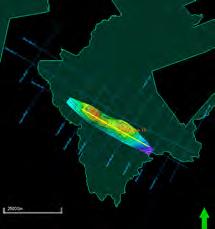

The es�mated volume for prospec�ve resources is of 18,915 BCF.
There are clear advantages to using data and AI to build digital network twins. Its capabilities to complete non-existing data points allows it to create a model even with incomplete or “small” data. This being said, there is one major limitation: AI is a prisoner of the world it has to learn from.

promo�on@perupetro.com.pe

www.perupetro.com.pe
.com.pe)
www.UpstreamOpportuni�es.pe Perupetro
PERÚPETRO
Promo�on Execu�ve Vilma Ruiz Burneo (vruiz@perupetro
General Manager Daniel Hokama Kuwae (dhokama@perupetro.com.pe) Explora�on Manager Eris Gabriel Valverde (egabriel@perupetro.com.pe) Promo�on & Contrac�ng
AVAILABLE DATA Wells: 7 Exploratory Wells (Wildcats) Acquired 2D Seismic: 8,272 Km (1973-2010) 2D Seismic Reprocessed 2019: 1,800 Km (PSTM), 780 Km (PSDM) 2D Seismic Enhanced by Searcher 2021: 7,923.7 Km Magnetotelluric: 2 lines with 78 sta�ons PROSPECTIVE RESOURCES 06 Prospects : 5.7 TCF 21 Leads: 14.7 TCF 05 Plays (An�cline 3-4 way closure) Total: 20.4 TCF and 320.59 MMSTB LGN (2U) (Unrisked)
Basin Area: 7.5 MM Ha. Source Rocks: Cabanillas (Devonian), Ambo (Lower Carboniferous) Reservoir Rocks: Vivian-Lower Chonta (Cretaceous), Upper Nia -Lower Nia (Permian) Fluid Type/ °API: Flow Gas and Condensate (Candamo-1X) and 50.8° (Pariamanu-1X) Prospect “Kusak” Reservoirs: Vivian, Lower Chonta and Nia Avr. Depth: 5,000 m Fluid type: Gas and Condensate GLOBAL VOICE OF GAS DECEMBER 2022 32
(oficial)
S.A - Oficial
.com.pe)
Manager Carlos Pan�goso Andonaire (cpan�goso@perupetro.com.pe) Contract Supervision Manager Carlos Bianchi Ramirez (cbianchi@perupetro
•
•
The LNG state of play post-COP27
LNG is poised to play an important and ongoing role in creating a more sustainable future by expanding the reach of clean and abundant gas to regions located long distances from existing supply infrastructure.
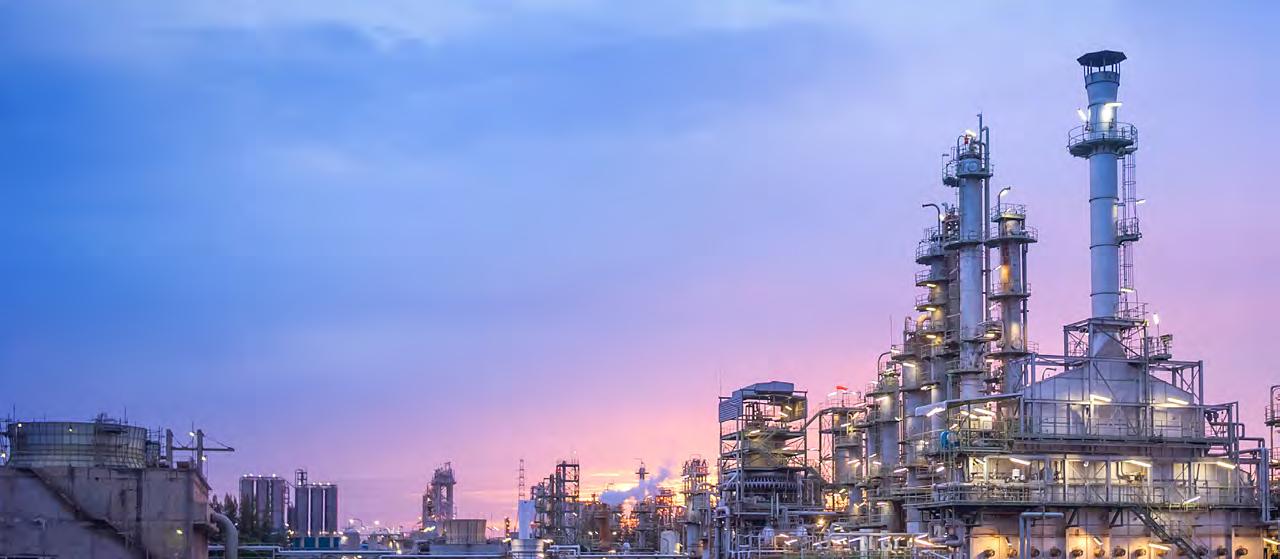
The post COP27 energy landscape is characterised by continued pledges to implement measures to reduce emissions, but with an implementation deficit. Commitments and actions are growing, but they still fall well short of what is needed to limit the rise in global temperatures to 1.5 °C and avert the worst effects of climate change.
The combination of the push to net-zero and a sustainable future world is expected to cost trillions of dollars and requires far more energy than renewable technologies alone can provide. For developed countries, not achieving global climate targets means some additional discomfort in the medium term and a rocky transition to a cleaner energy future; for developing countries, not achieving global climate and emissions targets means continuous testing of their resilience as these countries teeter on the edge of viability.
As the world moves toward cleaner energy sources, natural gas is recognised as having an important role to play in the new energy future. LNG will remain a critical input in ensuring that we achieve affordable and secure climate mitigation.
In the medium term, LNG fundamentals remain strong. Global LNG markets are expected to be tight as Europe’s quest to reduce its dependency on Russian gas increases demand for LNG. This will have knock-on effects on demand growth in China and emerging Asian demand as European markets outbid them for the limited amount of flexible LNG supply.
With tight supply anticipated in the coming five years, prices are expected to remain at elevated levels compared to historical averages over 2017-19, before COVID-19. Moreover, we expect LNG-derived coalto-gas substitution during this period to reduce carbon emissions. With more coal power generation than the LNG needed to substitute for coal, it is expected that there will be healthy LNG demand as well as a short-term fall in emissions.
Expansion in LNG export capacity is projected from countries in Africa such as Mozambique, Australia, the US, Canada and the Middle East. Complementing this is a projection of increased LNG import capacity in key European countries.
There are plans for additional LNG import capacity development in India, Thailand, Vietnam, China and Korea. Global LNG consumption could more than double by 2030, potentially reaching over 600 MT/year under current proposals.
The expansion of LNG infrastructure in this period can be considered as an unanticipated mitigation measure against a potential lack of global climate action implementation to limit temperatures to 1.5 °C or 2 °C. However, long-term LNG expansion is generally not compatible with the potential for emissions reductions (with Paris climate targets of limiting global warming to between 1.5 °C and 2 °C) from LNG through coal-to-gas switching has a hard limit, determined by the availability of coal-based generation. Demand for LNG is expected
Source: Shuting Yang et al (2022) Environ. Res. Lett. 17 064048
to gradually decline as developed countries decarbonise, partially substitute renewables for LNG and ramp up their use of hydrogen from non-fossil fuel sources. While there is no bottleneck in terms of aggregate LNG terminal import capacity, there is a potential shortfall in LNG export capacity additions that can fully utilise the spare capacity in import terminals, as growth slows in natural gas consumption. Figure 1 shows the shifts in LNG export and import capacity between 1970 and 2050.
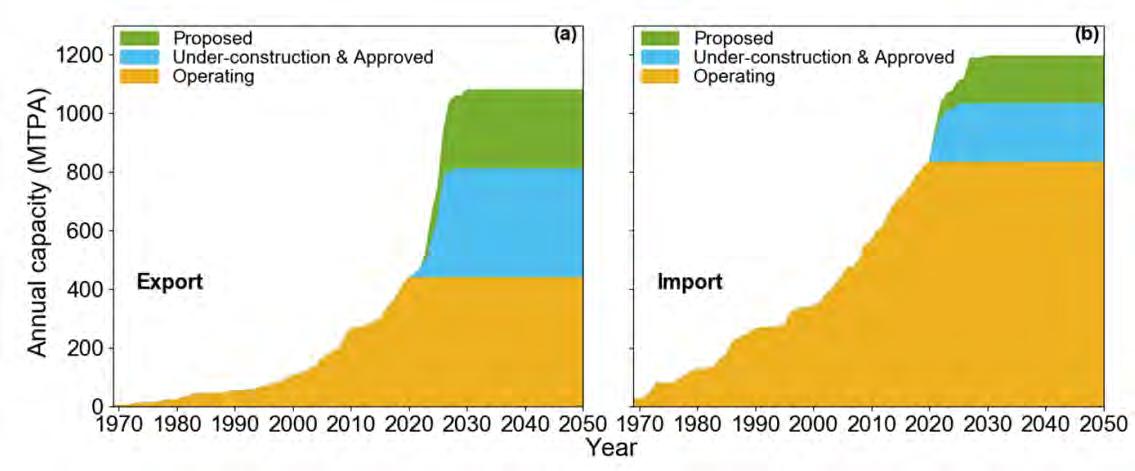
But this is not the whole story. Most countries will rely on a combination of mitigation actions, adaptations to climate change, and stakeholder collaboration with internal and external parties to balance the core dimensions of the energy trilemma: affordability and access, energy security and environmental sustainability. In addition, developing countries will have to battle a combination of fiscal constraints, limited financing headroom without restrictions and continued testing of infrastructure and overall viability through climate events. Consider the Caribbean. For these economies, energy resilience must include sufficiency, reliability, consistency and affordability of energy supplies in the short term, with long-term infrastructure investments incorporating environmental and sustainability concerns, and resilience to climate and other shocks. Among challenges faced by Caribbean energy importers are that dependence on fossil fuels perpetuates a lack of energy security, translating to risks for the economy, environment, and
society. Net Caribbean energy exporters face different impacts and different challenges, not least being the pace of transition and a need to balance the use of natural resource endowments for economic development with the responsibility of reducing the impact of their carbon footprints.
While transition orthodoxy and the abundant availability of renewable energy sources in the Caribbean seem to point to a direct path to renewables as the optimal strategy, unique economic challenges and lack of fiscal wiggle room make such a direct transition impracticable. This suggests that a more optimal path for economies such as these may be a transition to natural gas through LNG (scaled appropriately), in addition to renewables.
In short, LNG is poised to play an important and ongoing role in creating a more sustainable future by expanding the reach of clean and abundant gas to regions located long distances from existing supply infrastructure. To maximise existing resources and mitigate the loss of reserves due to stranding, an expansion of the micro-LNG concept (LNG imports and exports, scaled down) will be critical in the coming years as the world increasingly moves towards a more decentralised and distributed approach to power generation. Micro-liquefaction will also accelerate the growth of LNG as a transportation fuel and open new markets for natural gas in regions that have traditionally relied on diesel as a primary fuel source.
This article is brought to you by The National Gas Company of Trinidad and Tobago. The opinions and views expressed in this article do not necessarily reflect those of the IGU or the publisher.
Figure 1: Global annual nameplate (a) LNG export capacity and (b) LNG import capacity by project status—proposed (green), under-construction and approved (blue), and operating (yellow) from 1969 to 2050. All the LNG terminals are up to date of November 2020.
GLOBAL VOICE OF GAS DECEMBER 2022 34
Supply crunch prompts fall in global gas demand
ROSS MCCRACKEN
Global gas consumption has fallen only twice in the last two decades – in 2009 in the aftermath of the 2008/09 global financial crisis (-2.1%), and, in 2020, as a result of the demand slump wrought by the COVID-19 pandemic (-1.6%).
This year, demand is expected to fall again, owing to the profound shock resulting from the war in Ukraine and the consequent disruption to Russia-EU gas trade. However, unlike the demand-side led declines in 2009 and 2020, in 2022, consumption is expected to fall because of a lack of affordable supply, leaving gas demand unmet.
In regions where gas is readily available, notably North America, demand has continued to increase. Despite higher prices, US gas demand is expected to rise across all end-use sectors this year.
Future growth downgraded
The International Energy Agency (IEA) forecasts that global gas demand will fall 0.5% this year and then grow only slowly through 2025. Having previously forecast 5% growth for the period 2021-24, equivalent to 210 bcm, the IEA now estimates 2% growth, equivalent to 75 bcm. However, there is a big difference between LNG and pipeline trade. Global LNG trade is expected to increase by an average of just under 4% a year from 2021-2025 (a slower rate than in preceding years), while long-distance pipeline trade drops by an average 1.9% a year. The relatively slow growth of LNG is a function of a lack of new investment decisions preceding the war in Ukraine.
The two principal drivers behind the much-reduced
outlook are Europe’s desire to phase out its use of Russian gas – hitherto its largest source of imports – and demand conservation and destruction globally as a result of high gas prices, particularly in the LNG spot market. This raises the question of how gas demand will rebound, if it can, and what forces will shape its immediate and longer-term future in what will undoubtedly be a ‘new normal’.
Gas demand components
The IEA’s analysis of the drop in gas demand this year suggests less permanent demand destruction than perhaps might be expected. About 40% of its downward revision is the consequence of slower economic growth. 40% results from decisions to delay plans to switch from coal or oil to gas, alongside an increase in decisions to switch away from gas.
The agency says that only 20% of its downward revision is the result of efficiency measures and the substitution of gas for other fuels and energy sources. Of the downward revision, 55% is accounted for by mature gas markets with Europe accounting for the largest share. China and India account for a combined 15% and emerging markets the remaining 30%.
In terms of future demand growth, Asia-Pacific accounts for almost half of the increase to 2025 and the Middle East one third. North America and Africa see modest growth, while demand stagnates in South and Central America and Eurasia, and the decline is heavily concentrated in Europe.

In terms of end user demand, the IEA sees industrial
demand as the principal driver of growth, accounting for 60% of the downgraded increase to 2025. Power generation’s contribution falls to less than 10% over the 2021-25 period, as a result of high gas prices, lower electricity demand growth and increased renewable generation. In Europe, gas-for-power demand falls 17% as the region seeks to limit its exposure to gas imports.
Planned distribution network expansion in China, India, and Iran results in higher retail consumption, but heating demand is expected to decline in all mature markets. Some demand growth is expected in the transport sector, principally in China, India, and the Middle East.
Europe: at the centre of the storm
EU gas consumption in the second quarter dropped 16%, or 13.9 bcm year on year, according to Eurostat data. Gas imports were up 3%, despite the slump in Russian gas supplies as more pipeline gas from non-Russian sources and LNG was imported, allowing Europe to refill its storage inventories ahead of winter.
The primary components of the drop in second quarter demand were reduced gas-fired generation, which dropped 7%, less activity on the part of energy-intensive industries, and warmer weather limiting heating demand. The drop in gas demand was particularly heavy in both percentage and volume terms in Germany (-22%) and the Netherlands (-25%).
The fall in gas-fired generation was stemmed by
very high coal prices, stable carbon pricing and by less physical capacity to switch, owing to earlier closures of coal plants.
According to the Brussels-based think tank Bruegel, demand reduction over summer came principally from energy-intensive industries, but, by October, significant reductions in household demand were also evident, aided by warm weather. Bruegel estimates EU gas consumption at 10% below the average for 2019-2021 for the JanuaryOctober period, but with demand 25% lower in October. Across the bloc, the second-quarter fall in gas-fired power generation has been reversed, leaving gas for power demand up 1% over January-October, while industrial and household demand were both down 13%, according to Bruegel.
North America hits demand high
The contrast with the US could not be more evident. The US Energy Information Administration (EIA) estimated in September that US gas consumption will hit a record 86.6 bcfpd (2.5 bcmpd) this year, with demand increasing across all end-use sectors, despite sharply higher prices. The increase is led by the power sector. The rise in gas prices did not result in a significant switch back to coal as a lack of coal supply and high levels of coal plant retirements stymied increased power generation from the high emissions fuel.
US gas prices did not reach anything like European levels, but, averaging $6.41 per mmBtu in the first eight
Unlike in 2009 and 2020, supply-side factors have left gas demand unmet this year as high prices deter consumption
Total Power Industry Household -20 -10 0 10 20 30 40 50 Germany
GLOBAL VOICE OF GAS GLOBAL VOICE OF GAS DECEMBER 2022 DECEMBER 2022 36 37
France Italy Spain EU27 Natural gas demand in Europe, Jan-Oct 2022 vs 2019-2021 average, main economies (%)
months of 2022, were about double the previous year’s levels and more than three times the prices seen in the peak COVID lockdown year of 2020. The power sector is the largest user of gas in the US, but demand increases are also forecast in the residential, commercial, and industrial sectors.
Asia-Pacific – established LNG importers
China has seen a sharp drop in LNG imports this year, with volumes 20% lower in the January-September period year on year. Both Japan and South Korea have responded to high prices by falling back on coal and nuclear generation and eschewing spot market LNG purchases where possible.
In China, which emerged as the world’s largest importer of LNG last year, high gas prices have not been the only factor reducing demand. Heavy coronavirus restrictions continue to have an impact on economic activity. State oil and gas company PetroChina forecasts that the country’s gas demand growth could see the lowest annual rate on record and even fall, reflecting a combination of brakes on the economy and high international gas prices.
From January-September, gas demand totalled 269.5 bcm, according to data from the National Development and Reform Commission, down 1.4% year on year.
The PetroChina forecast is significantly lower than one made in August by the National Energy Administration of 1-3% growth for the year as a whole. The eventual outcome depends on how cold the winter proves to be. China has tended to prioritise city gas use and industrial consumption, and to a lesser extent gas in transport, rather than gas for power generation. According to PetroChina, city gas demand accounts for more than 75%
of total consumption in the winter.
Whether gas demand rises or falls slightly over calendar 2022, the slowdown in the rate of demand growth is severe. Chinese gas demand rose 12.8% in 2021 and recorded annual average growth of 10.9% from 20112021.
Emerging Asia priced out of the market
Other Asian markets have been more adversely affected. Both Pakistan and Bangladesh have had to scrap LNG tenders this year, receiving unaffordable offers, or none at all. Thailand has also found itself priced out of the spot LNG market.
Pakistan and Bangladesh are dependent on LNG to address domestic gas deficits, leaving them with little choice but to fall back on higher fuel oil and coal imports, as well as facing power shortages. Both have suffered extensive rolling blackouts as a result of an inability to source spot LNG volumes.
In India, gas consumption is forecast by the IEA to fall 1.5% this year and LNG import volumes in the first 8 months of the year were down 14% from the year earlier period. Declines in particular sectors are much more severe; -28% year on year for the period January-August for power generation, -29% for refining and -23% for chemical production.
Other users, which receive some price protection as a result of India’s gas pooling and pricing policies – fertiliser production, city gas distribution, agriculture and some other industries – saw small increases in demand.
In the first half of the fiscal year (April-March), natural gas prices under the country’s administrative pricing formula rose 110% and in the second half will increase a further 40% to a record $8.57 per mmBtu, affecting
Global energy demand by source (EJ)
War
Oil
around 60% of city gas volumes. According to ratings agency CRISIL this will reduce expected growth in city gas distribution from an expected 20-25% to 8-10% this year. Industrial users are switching to oil-based alternatives, such as diesel or propane, while the price differential in transport between compressed natural gas versus gasoline or diesel has narrowed.
What next?
Europe’s relationship with gas has clearly changed as a result of the war in Ukraine. The determination to phase out Russian gas imports can only be managed effectively in the context of reduced demand for the fuel as a whole. This will require more renewables, sooner. However, Europe, in the short-term, finds itself in the contradictory position of encouraging non-Russian gas production and imports at the same time that it pursues policies designed to remove the fuel from its energy mix more aggressively over what is often called the ‘longer term’. This longer-term is already a time span shorter than the lifetime of the assets it wants to see invested in. Other regions find themselves in less ambivalent positions.
The growing availability of affordable gas as a source of imported energy, led by the LNG industry, provided a secure, low-emissions fuel able to displace coal and oil from generation mixes in both developed and developing economies. In particular, and in conjunction with renewables, it formed the centrepiece of energy
transition strategies for many emerging economies facing a challenging combination of heavy dependence on coal and rapid energy demand growth.
In the short-term, these plans have been badly rocked. Countries like Vietnam or the Philippines, which are on the cusp of entering the LNG market, may now delay or reduce the role they see gas playing in their future energy mixes.
However, China’s response is instructive. Faced with huge dependence on coal domestically, there is a pragmatic realisation that the energy transition requires an ‘all of the above’ approach, one in which gas’ lower emissions profile cannot be ignored. Chinese companies have this year and last been to the fore in agreeing new offtake agreements for LNG supply. This is needed to underpin new capacity to rebalance a world gas market thrown off kilter by Russia’s war with Ukraine.
Likewise in the US, where the EIA has identified coalto-gas switching as the primary driver of reduced US greenhouse gas emissions in the period 2005-2019, the process has still some distance to travel with the US coal fleet still more than 250 GW strong.
0 10 2030405060
April - Sept 2021 Apr - Sept 2022 Jan - Sept 2021 Jan - Sept 2022
China LNG China Pipeline India LNG
Chinese and Indian LNG imports fall (MT)
0 50 100 150 200 250 2001 2002 2003 2004 20052006 2007 2008 2009 2010 20112012201320142015 2016 20172018201920202021
Gas’s reputation as an affordable and secure source of energy has certainly been tarnished by war, but new investment, demand conservation and an acceleration of renewable energy deployment should eventually restore market order. At that point, most likely around 2025-27, the world will still be heavily dependent on coal and oil, and gas will still be a cleaner-burning alternative. GLOBAL VOICE OF GAS GLOBAL VOICE OF GAS DECEMBER 2022 DECEMBER 2022 38 39
Financial Crisis
in Ukraine Pandemic Gas Coal Renewables
No easy way out of energy crisis for Pakistan
Pakistan continues to struggle to procure LNG, and the situation is unlikely to be resolved until more supply comes onto the market in twothree years’ time.
ANNA KACHKOVA
Volatility in the gas market this year continues to affect South Asian countries’ ability to procure natural gas imports – particularly in the cases of Pakistan and Bangladesh. This has contributed to a worsening crisis in Pakistan, which has been grappling with energy shortages, inflation, currency depreciation, a depletion of foreign reserves and a widening current account deficit.
LNG prices remain high, and Pakistan and Bangladesh are among the countries increasingly finding themselves locked out of the spot market as they struggle to pay such prices. This situation looks unlikely to be resolved anytime soon, with LNG continuing to flow to Europe as European countries pivot away from Russian pipeline gas imports and buyers such as Pakistan struggling to compete.
The situation should ease in the medium term, however, as new LNG supplies come onto the market thanks to the start-up of a new wave of liquefaction capacity. But in the meantime, Pakistan’s options look limited and the country may find itself forced to reduce demand if it is unable to easily procure LNG or other forms of fuel.
Struggling to compete
The war in Ukraine has upended global energy flows, with European countries turning to the LNG market as they scramble to reduce their dependence on Russian gas imports. And European buyers are in a stronger position to pay higher spot prices, creating difficulties for Pakistan.
“The spot LNG is available but it’s going to the highest payer, and the highest payers at the moment are European buyers,” Rapidan Energy’s director of global gas, Alex Munton, tells Global Voice of Gas. “It’s just the harsh reality of being in this extremely tight, ultracompetitive market where there’s a significant scarcity of supply. Europe is bidding up the price of spot LNG to a level that Asian buyers like Pakistan cannot compete with, beyond the level that Pakistan is willing to pay for,” he added.
Indeed, Pakistan has repeatedly struggled to complete LNG tenders recently, having previously bought around half of its LNG on the spot market last year. It had been one of the fastest-growing LNG markets over the past few years, according to Munton. But in June, a third LNG tender for July was scrapped without any volumes procured amid reports that the only offer would have been the most expensive cargo ever delivered to the country.
In October, a tender for longer-term supply of LNG over a period of 4-6 years also failed, having reportedly not attracted any sellers.
The situation is further complicated by some hesitancy among sellers to supply LNG to Pakistan out of concern that the country may not be able to make payments in the future.
“Sellers are hesitant to sell to Pakistan,” a Wood Mackenzie senior research analyst, Raghav Mathur, tells GVG. “In the current LNG market situation where sellers can be choosy and picky, even the smallest changes in terms and conditions can complicate matters. Hence, a deferred payment option will only reduce Pakistan’s chances of procuring LNG,” he says.
Pakistan has an existing long-term supply agreement in place with Qatar that it is increasingly reliant on in the face of its ongoing struggle to procure new volumes. There is no immediate prospect of an improvement.
“Pakistan will have challenges for procurement of gas,” Mathur says. “It seems difficult that they will be able to procure LNG through long-term contracts,” he continued. “If the spot prices do come down for certain timeframes next year, then they will have to compete against other buyers who are better equipped to price that LNG away from them. However, what they can do is, maybe leverage their existing relationship with Qatar under their existing long-term contracts and maybe seek extra volume for a short duration of time next year.”

GLOBAL VOICE OF GAS DECEMBER 2022 41 GLOBAL VOICE OF GAS DECEMBER 2022 40
Pakistan’s options look limited and the country may find itself forced to reduce demand if it is unable to easily procure LNG or other forms of fuel.
Exploring options
Against this backdrop, there has been speculation that Pakistan could turn to Russia as its energy sources are increasingly shunned by Western buyers in particular. Indeed, Pakistani government officials visited Russia in late November for talks on issues that included oil and gas supplies. However, turning to Russia also does not appear to be a straightforward proposition.
“It is important to note that Russian gas/LNG is still flowing to various areas of the world – Europe and Asia both – not out of choice but rather necessity,” says Mathur. “Energy security is the main reason for many of the countries and it seems like Pakistan might also follow the same road. From a Russian perspective, they will be wary of the fact that Pakistan will not be able to pay up as quickly or as per Russian requirements, hence long-term deals or high-volume deals will not be possible in short term.”
Munton, meanwhile, points out that most of Russia’s LNG is already committed to other buyers.
“Russia has two LNG projects – Sakhalin in East Siberia and Yamal LNG in West Siberia. Most of it is spoken for,” Munton says. “It doesn’t hold a lot of spot capacity and flexible supply itself. It just doesn’t have the volumes.”
Overriding existing customers would throw up its own challenges, and is not a move Russia is likely to make unless it sees a clear political advantage in doing so. But given the misgivings about Pakistan’s ability to pay for future volumes, such a scenario is unlikely to play out.
Nonetheless, Pakistan’s Minister of State Petroleum Musadik Malik said on December 5 that his government


had engaged with private Russian firms over LNG imports and that Moscow had also invited Islamabad to initiate talks over long-term contracts to buy the super-chilled fuel. This came as Russia also agreed to sell Pakistan some discounted crude, gasoline and diesel, offering the country some breathing space. However, negotiating a long-term LNG contract would take time and while Russia is in the process of expanding its LNG capacity, a lack of spare volumes complicates the process.
No short-term answer
The short-term situation threatens to force Pakistan to turn to alternative energy sources, and the government has previously said it would do so, shifting away from some LNG imports to other fuels.


“Switching to alternate fuel is the only prospect left for Pakistan,” says Mathur. “If LNG deals do not fructify then Pakistan will have to import oil and coal, otherwise it will lead to blackouts and an energy crisis within the country. This could last 2-3 years, depending on global LNG market developments.”


However, Munton cautions that Pakistan’s gas market is “not easily replaceable” with alternative sources of energy.




“Pakistan will have trouble getting LNG as long as Russian pipeline supplies to Europe are limited, which is not likely to change in the near future,” Munton says.
“Supply conditions will improve in about two-thre years, when the large amount of new LNG capacity that is currently under construction globally comes online. Until then, the choice Pakistan will continue to face will be either to pay high-priced spot LNG or reduce demand.”
In a complex and changing natural gas market, our clarity is your edge. With unparalleled breadth and depth of data and insight we provide a unique and powerful perspective.


Read our latest report
‘New Configurations: America’s Gas & Power in Net Zero’. at spglobal.com/futureofgas


Opportunities in sight. The future in focus.
“Pakistan has an existing long-term supply agreement in place with Qatar that it is increasingly reliant on in the face of its ongoing struggle to procure new volumes.”
GLOBAL VOICE OF GAS DECEMBER 2022 42
India sees a coal comeback amid soaring gas prices

High gas prices are forcing India to resort to alternative fuels, including coal, and denting growth in the market for compressed natural gas as a vehicle fuel. The government is also having to shell out more in fertiliser subsidies
India’s government has been forced to jack up domestic natural gas prices in response to soaring import costs. This has prompted consumers to switch to alternative fuels, primarily coal, spelling bad news for the country’s climate objectives.
The Indian government increased the regulated wholesale prices by 40% at the start of October. The price of domestically-produced gas is set every six months through a formula linked to global rates, which have risen sharply in the last half-year. Record-high prices have hit Indian gas consumption and has forced some industries to look for cheaper alternatives.
In the October 1, 2022 to March 31, 2023 period, the price paid to most domestic natural gas producers will be $8.57 per mmBtu, up from $6.1 per mmBtu in the April 1 to September 30, 2022 period. The government also announced an increase in the price of gas from difficultto-exploit fields, including those in deep waters and containing high-pressure, high-temperature reservoirs, to $12.46 per mmBtu from $9.92.
The impact of elevated prices is visible on domestic consumption. Demand in April through September, representing the first half of the 2022-2023 financial year, totalled 31.48 bcm, down 4.7 % year on year, according to the Indian government.
Impact across sectors
The gas which falls under the administered price mechanism (APM) is supplied largely to compressed natural gas (CNG) and domestic piped natural gas (PNG) consumers, who contribute to 50% and 10% of the city gas volume, respectively, according to a CRISIL report
published in early October.
CRISIL believes with high prices set to remain, Indian city gas consumption will grow by only 8-10% this fiscal year, versus an earlier projection of 20-25%.
“Elevated gas prices are expected to reduce demand for industrial PNG by 10-12% this fiscal, as price-sensitive industrial consumers switch to alternative fuels such as propane and fuel oil,” said Naveen Vaidyanathan, director, CRISIL Ratings.
“Demand for residential PNG, although more resilient to higher prices, may also grow a modest 2-5% as employees return to office with the COVID-19 pandemic subsiding. CNG demand is still expected to rise 25-30% on the back of an expanding network of CNG stations to new geographic areas and higher sales of factoryfitted CNG cars, despite narrowing price differential with competing petrol and diesel,” he added.
City gas distributors have been taking successive price hikes since April 2021 to manage their cost pressures. For instance, CNG prices having increased by a massive 75%. The hike in the CNG price has reduced the cost advantage that the fuel enjoyed compared with gasoline and diesel, impacting the number of CNG vehicles sold in the country.
According to a report published by Economic Times on September 30, the Indian automobile industry has trimmed the estimate of the number of CNG vehicle that will be sold in the year ending March 2023 by 25-30% to 500,000-550,000. This would still be much higher than 261,000 CNG passenger vehicles sold in India in the 2022 financial year.
The Indian manufacturing sector has been bearing the
SHARDUL SHARMA
VS Gasoline VS Diesel FY20 FY21H1FY22H2FY22H1FY23 H2FY23* 51% 37% 59% 47% 65% 54% 44% 26% 42% 26% 32% 14% Percentage that CNG is cheaper than gasoline and diesel (Rs/km) *Assuming complete pass-on of recent hike in APM gas prices and unchanged petrol/diesel price. Computed for Delhi. Credit: Crisil GLOBAL VOICE OF GAS DECEMBER 2022 45 GLOBAL VOICE OF GAS DECEMBER 2022 44
brunt of high gas prices as well. According to a report published by Financial Express in early November, more than 300 of the 800 units in India’s biggest ceramic cluster town of Morbi in the state of Gujarat have switched from natural gas to more affordable propane. Reduced demand has forced state government-owned gas utility Gujarat Gas to cut gas supply volumes to the cluster from 7 to 2 mcm per day. The ceramic manufacturers of Morbi cannot use coal gasifiers because of court orders.
Haresh Bopaliya, president of Morbi Ceramic Association told Financial Express that despite the recent reduction in price of gas by Gujarat Gas, propane is still cheaper by 15 rupees per unit. Over the past year and a half, the PNG price has gone up from 35 to 63 rupees per cubic metres, before recently being cut by 5 rupees.
The Morbi cluster accounts for more than 75% of the total ceramic production of India. Its annual turnover is over 450bn rupees ($5.5bn), and that includes 120bn rupees worth of exports.
Bloating fertiliser subsidy bill
The India government’s fertiliser subsidy bill could increase by about 400bn this fiscal year from the previously-announced allocation of 2.15 trillion rupees, because of the continued surge in the price of gas – a key feedstock for producing urea. The pool gas price – the average price of domestic gas and imported LNG used by fertiliser plants – increased from average $22 per mmBtu as of June to around $25 per mmBtu in September this year.
In addition to 1.05 trillion rupees approved in the federal budget for this fiscal year, an additional subsidy of 1.1 trillion rupees for fertilisers was announced in May 2022 to offset surging feedstock and product prices. While this seemed sufficient to meet this fiscal’s requirements, the continued surge in the price of gas means more support is needed, CRISIL said.
“Amid the Russia-Ukraine conflict, the price of pooled gas has risen approximately 10% quarter-on-quarter in September 2022. The earlier expectation was prices would soften gradually. Each dollar’s increase in the price of pooled gas raises the government’s subsidy burden by 70bn on domestically produced urea, which accounts for 85% of the production volume,” Vaidyanathan said.
“The price of imported urea, which accounts for the balance 15% volume, remains elevated at over about $650 per T, almost double the historical levels. Together, this could mean overall subsidies rising to 2.55 trillion
rupees this fiscal,” he added.
Coal’s comeback
High gas prices are also forcing India to revert to more coal-fired power, the country’s finance minister Nirmala Sitharaman said recently.
“The Western world has seen countries moving to coal. Austria has already said, and today...they are going back to coal,” Press Trust of India quoted Sitharaman as saying during her visit to the US in October. “The matter of fact, it is now reviving itself as a thermal unit. So, it’s not just India, many countries have gone back. And coal is now going to be back again, because I think gas cannot be afforded. Or it is not available as much as you want.”
Nearly half of India’s gas demand is met through imports of cost LNG. High global LNG prices contributed to a 11.3% year-on-year decline in Indian imports to 11 MT in April through September, according to the Indian oil ministry. The import cost in the period was $6.6bn, up from $5.8bn in the same period last year.
The country’s minister of coal Pralhad Joshi earlier this year said in a written reply to parliament that India’s transition away from coal would not happen in the foreseeable future. Coal demand in India is set to peak as late as 2030, according to government forecasts, at 1,300-1,500 MT, 63% higher than today’s level of consumption. But a lot will depend on the outlook for global gas prices. Cheaper gas, as a result of greater international investment in supply, will give Indian consumers an economic, and not just a climate incentive, to quit coal faster.

Cheaper gas, as a result of greater international investment in supply, will give Indian consumers an economic, and not just a climate incentive, to quit coal faster.
GLOBAL VOICE OF GAS DECEMBER 2022 46 GLOBAL VOICE OF GAS DECEMBER 2022 47
“The Western world has seen countries moving to coal. Austria has already said, and today...they are going back to coal,” Press Trust of India quoted Sitharaman as saying during her visit to the US in October.
Engineering a sustainable world for a better tomorrow
Technip Energies brings our clients’ ground-breaking LNG projects to life, integrating technology and expertise. We are committed to enhancing their performance and accelerating the energy transition by offering solutions to reduce CO2 emissions from liquefaction and export terminals.
In Qatar, we are delivering the world’s largest Liquefied Natural Gas project including a large CO2 Carbon Capture and Sequestration facility that reduces CO2 emissions by around 25% when compared to similar LNG facilities. technipenergies.com

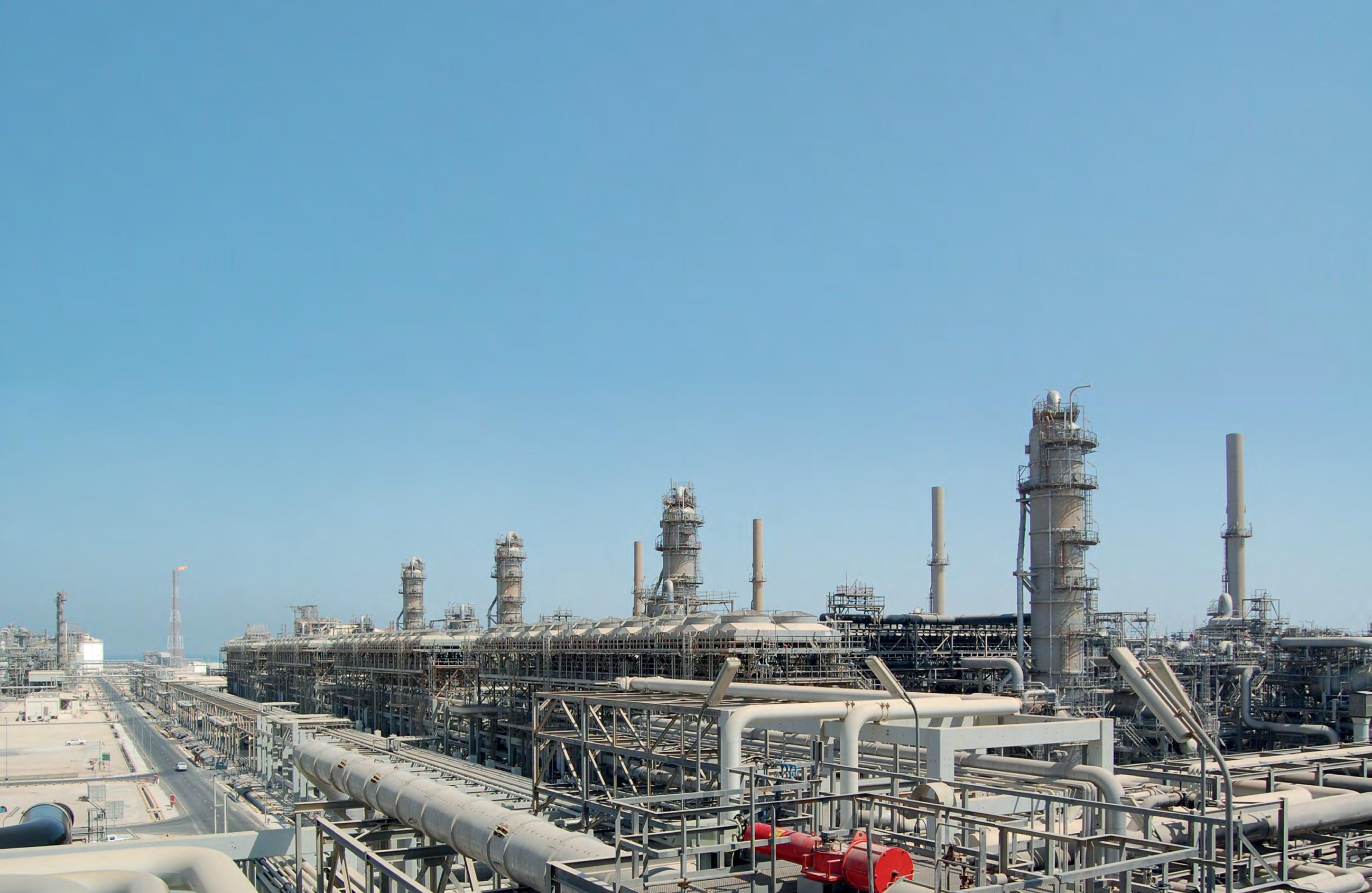
Where energies make tomorrow
A Publication of the International Gas Union (IGU) in collaboration with Minoils Media Ltd.
IGU Editorial Team
Strategic Communications and Membership Director
Tatiana Khanberg
Sr. Advisor Public Affairs Marta Gonzalez
IGU Leadership Secretary General Milton Catelin
President Li Yalan
Vice President Andrea Stegher
Advertising and Sponsorship Inquires
Greg Klausmeyer inquiries@naturalgasworld.com
Editor, Global Voice of Gas and Editor-in-chief, Natural Gas World Joseph Murphy
Publisher Minoils Media Ltd. Design Ifraz Khan
Senior Editors
Dale Lunan Ross McCracken
Back Office Manager
Lili Jenei
Vice President, Strategy & Engagement Joao Salviano
President H. Rick Gill
Global Voice of Gas
BY THE INTERNATIONAL GAS UNION
ISSUE 04 | VOL 02
International Gas Union 44 Southampton Buildings, WC2A 1AP London , United Kingdom E-mail: info@igu.org Website: www.igu.org
Minoils Media Ltd. c/o 595 Burrard St, Suite #700, Vancouver, B.C. V7X 1S8 Canada Telephone: + 1 604.644.6624 E-mail: engagement@naturalgasworld.com Website: www.naturalgasworld.com

Copyright © 2022.
The entire content of this publication is protected by copyright, full details of which are available from the publisher. All rights reserved. No part of this publication may be reproduced, stored in retrieval systems or transmitted in any form or by any means – electronic, mechanical, photocopying, recording or otherwise – without the prior permission of the copyright owner
Learn more at www.igrc2024.com Subscribe to receive IGRC2024 notifications! MAY 13-17, 2024 Fairmont
Springs
Host Association: Affordability . Reliability . Sustainability Technology Innovations . Clean Energy
Sponsorship package available. Contact Julie Gaudreau, Executive Director IGRC2024 | JGaudreau@cga.ca Presented by:
Banff
Hotel Banff, Alberta, Canada
International Gas Research Conference
GLOBAL VOICE OF GAS DECEMBER 2022 51
 BY THE INTERNATIONAL GAS UNION ISSUE 4 | VOL 02
BY THE INTERNATIONAL GAS UNION ISSUE 4 | VOL 02









 Tatiana Khanberg, Strategic Communications and Membership Director,
Tatiana Khanberg, Strategic Communications and Membership Director,



































































